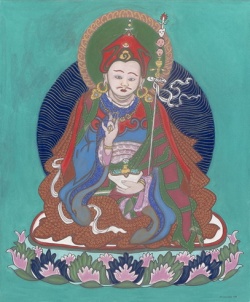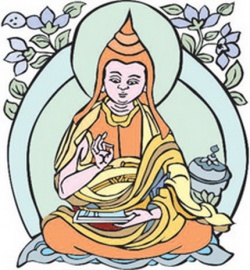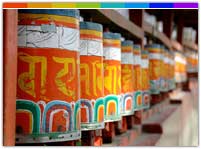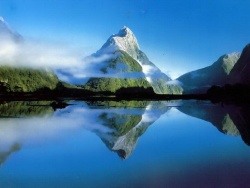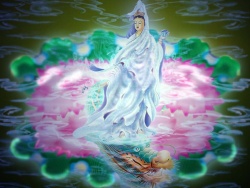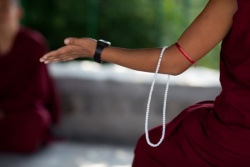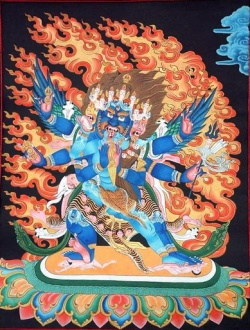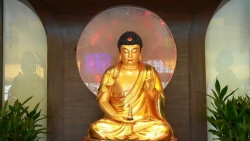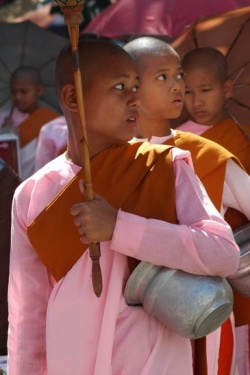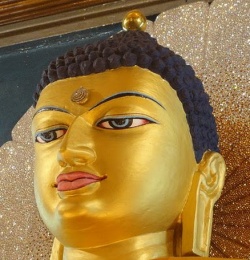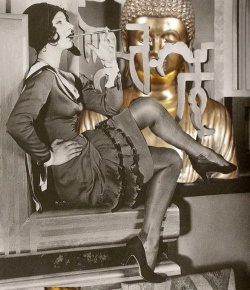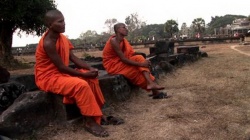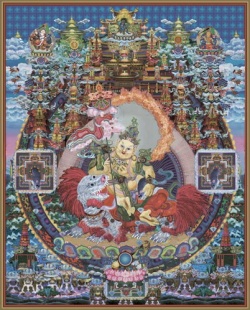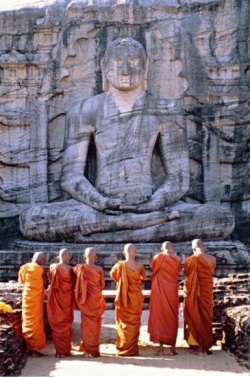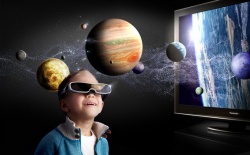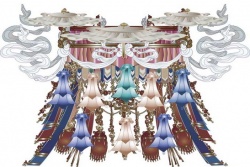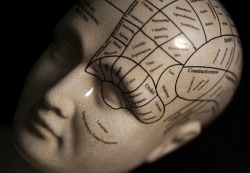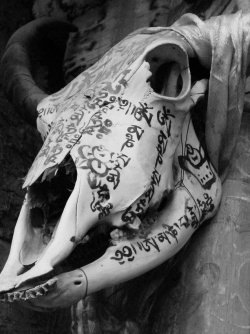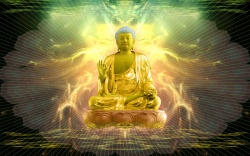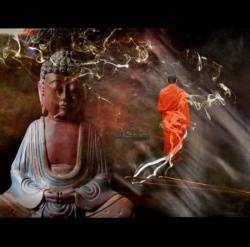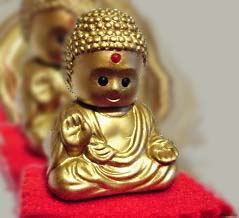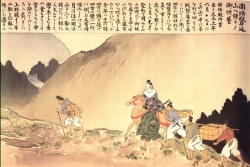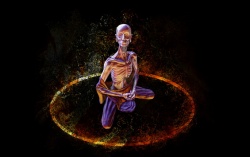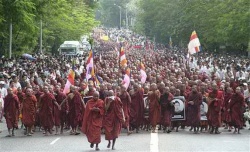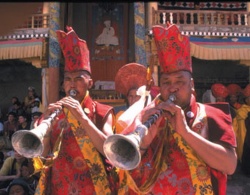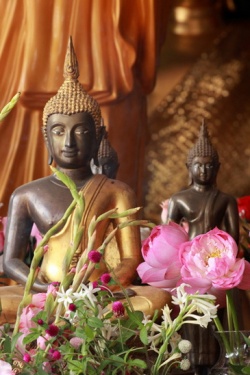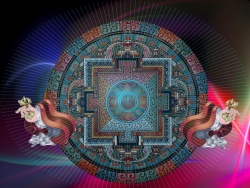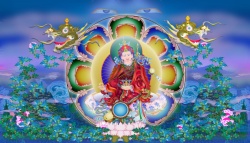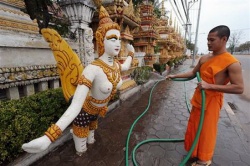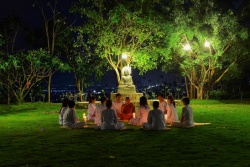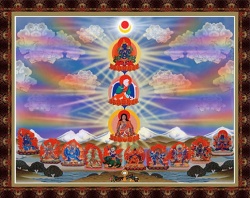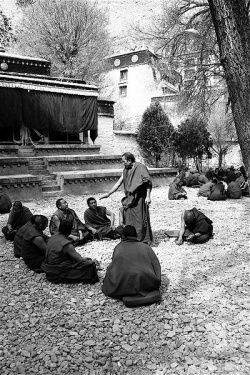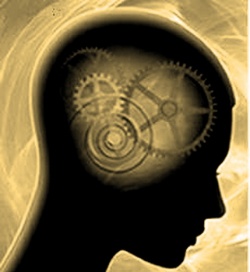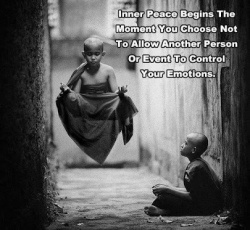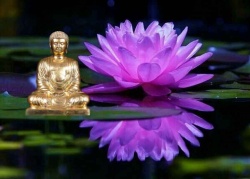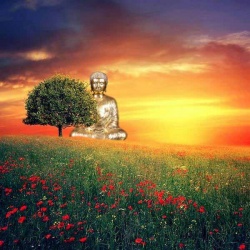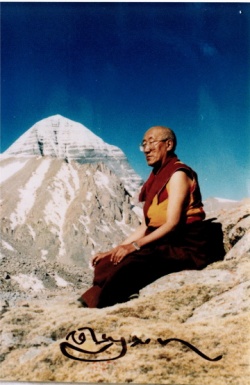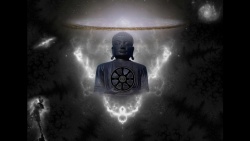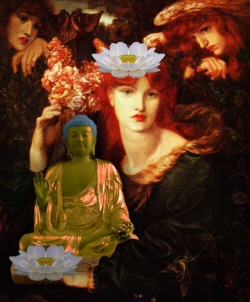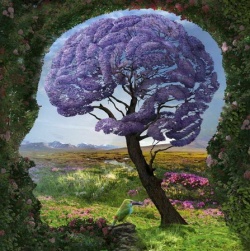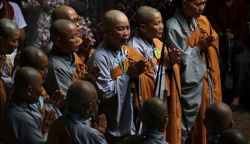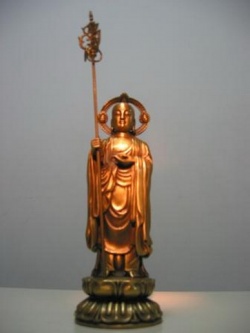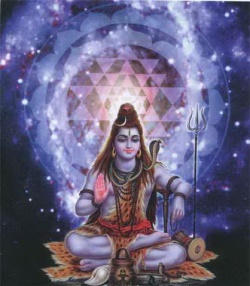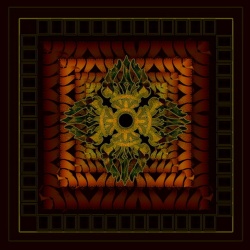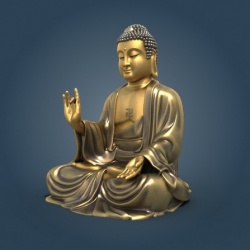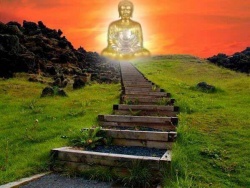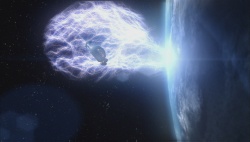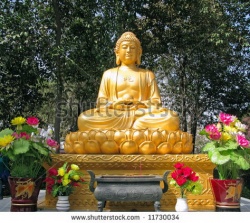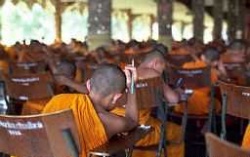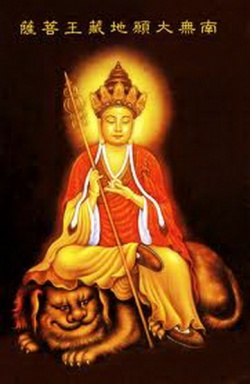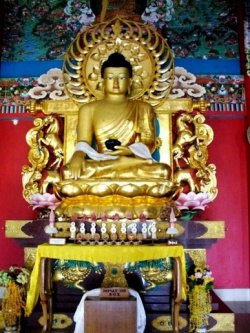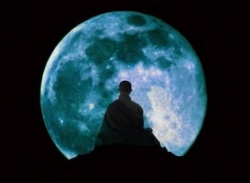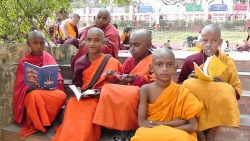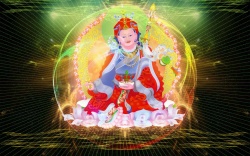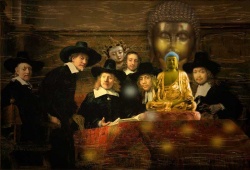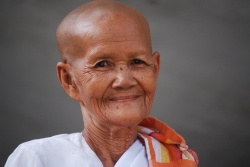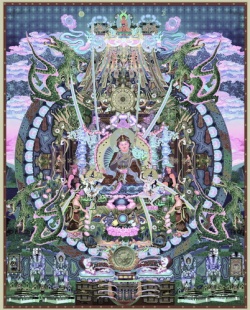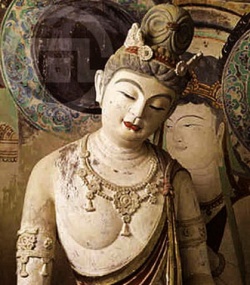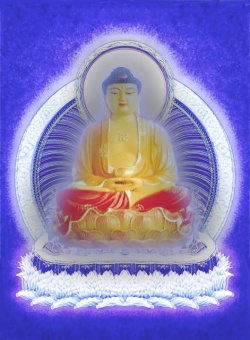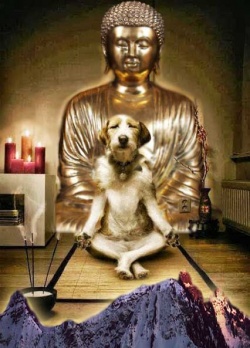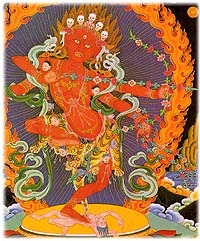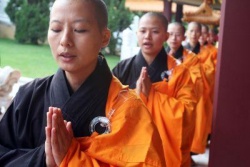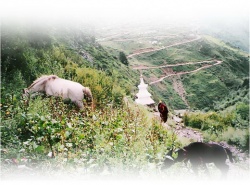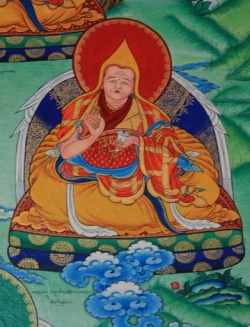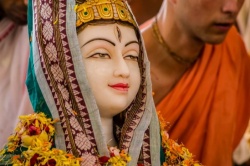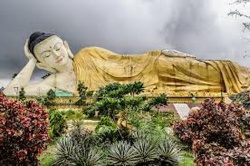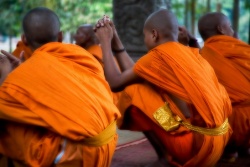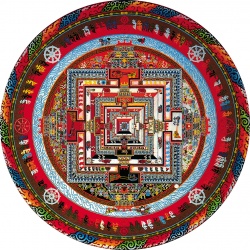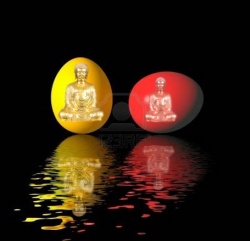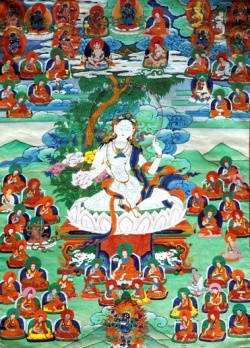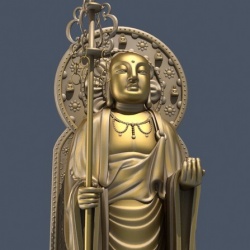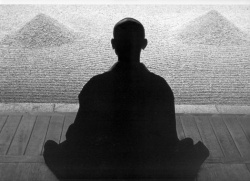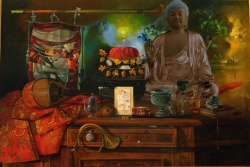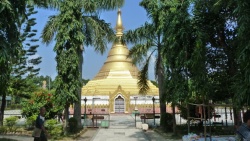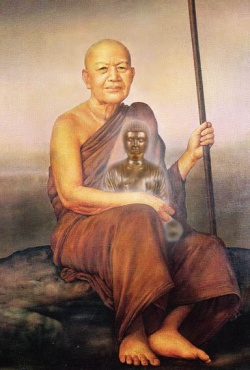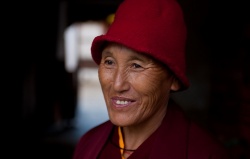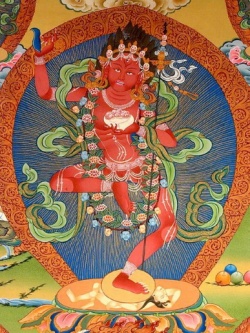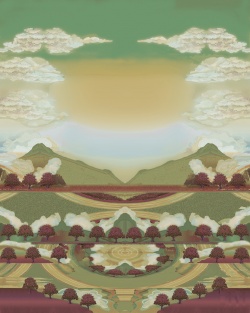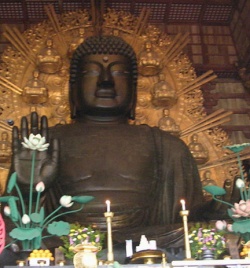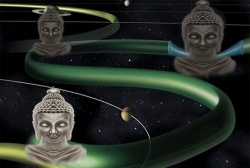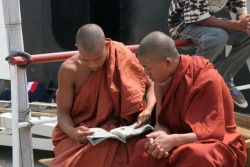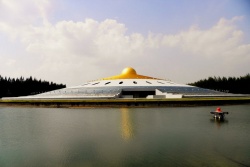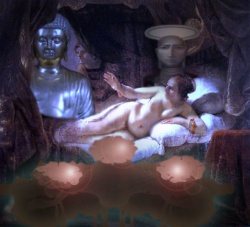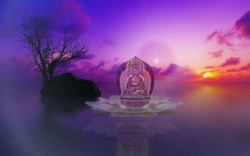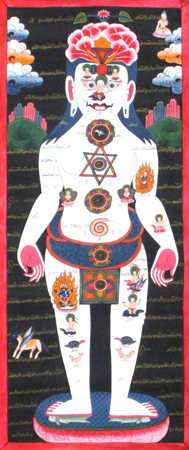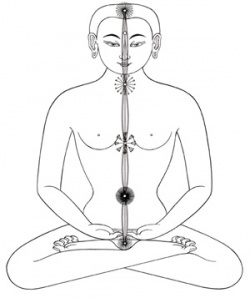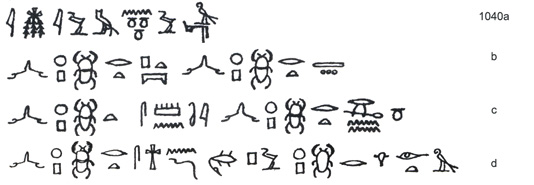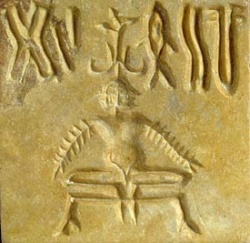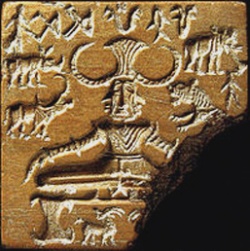On Buddhist Tantra
"This space within the heart - therein is the person, consisting of mind, immortal, resplendent."
- Taittirîya Upaniśad, 1.6
"There are those whose capacity of the Mahâyâna lineage is not meagre, whose minds are strongly moved by great compassion through having trained in the common path sustained by a spiritual guide, and excellent protector. They are in great haste to free from cyclic existence the kind mothers wandering there. They should enter the short path, the profound Vajra Vehicle that quickly bestows the state of a Blessed Buddha, the sole refuge of all sentient beings."
- Tsongkhapa : The Great Exposition of Secret Mantra, part one, Reasons for Faith.
"... those who destroy life and delight in lying, those who covet the wealth of others and are attached to sensual desires, those who eat faeces and urine, all these are worthy for the practice. The yogin who desires his mother, sister or daughter attains entire siddhi, the Dharma-nature of the supreme Mahâyâna ..."
- The Guhyasamâja Tantra, chapter 5.
"But in the first place, it is the one method of producing Heruka, and it is by such production that men are relased, O Vajragarbha of Great Compassion."
- The Hevajra Tantra, chapter 1:10.
"Seeing this excellent yoga supreme, the others are like worm-infested straw."
- The Cakrasamvara Tantra, chapter IV.
OM EVAM EKA TANTRA SIDDHI HUM !
Referring to the idea of a single underlying principle ("eka"), the Sanskrit word "tantra" means "weft, loom, warp, context, continuum". In Tibetan, "tantra" is known as "ju" ("rgyud"), meaning "thread, string", or "that which joins things together". Etymologically, the Sanskrit word "tantra" breaks down into the verbal roots √tran, or "propagate, elaborate on, expand on" and √tra, or "save, protect". Tantra spreads a teaching that saves. The word also refers to a specific text about esoteric spiritual practices, as in "Hevajra Tantra".
Introduction
The history of Indian Tantra is shrouded. Naming these special esoteric teachings & practices "Tantra" happened relatively late. Even in Buddhist Tantra, giving rise to a specific "path", the Vajrayâna or "Diamond Vehicle", also called Tantrayâna, Mantrayâna or Guhyamantrayâna, secrecy always remained essential, and so all key teachings were given, as in Western Qabalah, "from mouth to ear", and "received in order to bestow". This is still largely the case today.
As in Yoga, Tantra aims at a spiritual transformation opening the door to thedirect experience of the Divine here & now, entering the immediate awareness of the presence of the absolute (no longer overlayed with false ideation or even conceptualization).
In Yoga, this is the restriction of mental fluctuations hindering the "seer" to stand in his own-form, bringing about union ("samâdhi"). In this view, the outstanding feature of Tantra is its esoteric, "special" spiritual technology or set of salvic methods. In Hindu context, this was "kundalinî" tantra, in Buddhist practice, Deity Yoga & Mahâmudrâ tantra.
Indeed, India produced two main systems of Tantra : the Hindu & the Buddhist. The former was largely based on Śiva & Śakti (Śaiva Tantra, promoting the union of both), the latter on Heruka (union of wisdom & bliss). Recent scholarship evidences Buddhist Tantra to be rooted in Hindu Tantra, in particular Śaiva Tantra.
In Indian Tantra, the underlying transcendent principle is the quality of oneness ("eka"). The underlying principle or ground of being is not remote or uninterested in mundane, nominal, conventional existence. On the contrary, all possible activity is its actual display or play ("lila").
There is no "mundane" existence devoid (separated from) the Divine. Nor is there a separate "transcendent" existence. There is one pan-sacral reality (the One Thing). To call it "Śiva/Śakti" or "Heruka" does not eclipse the underlying nameless principle itself (the "Tao" of the Chinese).
Historically, the Mahâyâna introduced the Tantras. In the context of the Lesser Vehicle (Theravada), Tantra is pointless (and the Fourth Turning rejected). These Buddhists insist Tantra is not part of the actual teachings of Lord Buddha.
Others again assert they originate from Śaivism. There are also those who claim Śaiva Tantra was derived from Buddhist Tantra ! Traditionally, the origin of Buddhist Tantra is supposed to be rooted in the Fourth Turning of the Wheel by Buddha Śâkyamuni and meant for superior practioners only. To them, he appeared as Vajradhara, the Bearer of the Vajra.
These yogis had integrated the First, Second & Third Turnings and realized the nondual "seeing" of emptiness (on the first "bhûmi" & higher). They were Superior Bodhisattvas. Compassion & emptiness had been firmly attached before these "special" techniques were practiced. Initiation, secrecy & vows unavoidable.
From the 8th century onwards, i.e. with the rise of the Pâla dynasty of Bihar & Bengal (760 - 1142 CE), Buddhist Tantra became a systematic body of teachings and entered Buddhist universities. At that point, it was "purged" from explicit sexual acts (internalized) and formalized. Radically different from Hindu (Śaiva Tantra), it did not equate wisdom ("prajñâ") with Śhiva !
Antinomian (and a-social, transgressive) elements were deemed part of a "logic of reversal" -steeped in doublespeak & a "twilight language"- necessary for speeding up spiritual evolution by confronting & liberating negative states of consciousness directly (making "desire" part of the path).
Evoking, in a monastic context, afflictive & non-afflictive emotions (like anger, hatred, cruelty, arrogance, pride etc), was deemed possible (albeit highly ritualized & mostly visualized).
But explicit sexual acts were replaced by an erotic symbolism expounding the unity of compassion (the ultimate method to accumulate vast merit) and emptiness, realized by a wisdom-mind mounted on a luminous subtle body, i.e. the living unity of the Two Truths realized simultaneously (and not sequentially, or incompletely).
In Tibetan Tantra, initiated by Padmasambhava in the 8th century, this tantric union ("eka") may also be represented by an explicit sexual embrace (cf. "yab-yum", "father-mother") ; mostly a male Buddha with his female wisdom-consort.
Monks vowing to be celibate, mostly replaced this wisdom-consort (the woman with whom the male tantric is supposed to have sex with) with internal processes (sensualisations). However, in the Highest Yoga Tantra, actual erotic contact is deemed necessary !
Buddhist Tantra, the Highest Yoga Tantra in particular, is the special method to generate the mind of spontaneous great bliss and use this mind to meditate on emptiness, reinforcing this great bliss. The fact desire is integrated into the path is shared with Hindu Tantra.
Indeed, instead of renoucing the fire of the desire realm, wherein "all dharmas are on fire", the Buddhist tantric welcomes desire, but always together (simultaneous) with emptiness (i.e. with the absence of self-sufficiency in the desire at hand), feeding spontaneous bliss. Desire is the object of this highest "method" denying it self-subsisting, self-powered substance by an ever-present wisdom realizing the ultimate nature of all possible phenomena :
lack of substance but presence of process. This said, without compassion (revealing this process) and at least a generic image (concept) of emptiness (the culmination of the Path of Preparation), Tantra is dangerous, said to lead to an unwanted rebirth.
This is why Tsongkhapa stressed prelonged emptiness meditations before entering the tantric path.
In Tibet, Buddhist Tantra became strongly interlinked with specific yogic techniques, in particular Inner Fire Yoga, making the "winds" enter, abide and cease in the central channel of the subtle body (the so-called "Vajra Body"), and the preparation of this crucial event through Deity Yoga.
The importance of fire and the "flame of Agni" goes back to the Vedic seers (cf. the Keśin Hymn from the Rig Veda), while the Yogas for "moving the winds" may go back to Chinese (Taoist) sources.
Indeed, the importance & influence of the latter must be taken into account. Using Chinese information (from Inner Alchemy -Complete Reality School- and Ch'i Kung, especially the harmony between Wei Dan & Nei Dan manifest in the enlightened ones as the energetic balance between Li -Fire- and Kan -Water-), enables the Navayâna (new vehicle) to develop novel tantric techniques and better understand the traditional accounts (in particular those related to the "white" and "red" drops).
This may revolutionize Buddhist Tantra, making it more operational & less symbolic (restoring the original intent, ripping away cultural overlay & monastic adaptations).
Vajrayâna did not introduce a new view on reality and so is based on the same wisdom realizing emptiness as the Great Perfection Vehicle. The crucial difference being one of method only.
By filling the two "baskets" of merit (compassion) & wisdom (insight into reality) simultaneously (not sequentially), a crucial threshold, after which final enlightenment is attained speedily, can be reached with greater ease.
This technique it at the heart ("om") of all tantras ("tantra"), and is represented by the union ("eka") of wisdom ("e") and method ("-vam"), leading to the highest powers ("siddhi") & Buddhahood ("bodhi"), never leaving the mind pretending emptiness ("hum").
Calling, in the Great Perfection Vehicle, for three countless aeons of hardship, according to Tibetan sources, the goal of Tantra, Buddhahood, can be attained in one lifetime or less (three months ?) of relatively comfortable practice.
In Chinese Inner Alchemy & Ch'an Ch'i Kung (Da Mo), the foundational practices take hundred days and the method could be completed in at least three years, if not longer (depending on money, partner, techniques & place).
Let it be clear, the Fourth Turning is exceptional.
To bestow his own tantras, Lord Buddha, after his "parinirvâna" (?), appeared in the minds of Superior Bodhisattvas as Vajradhara.
In the tantric method, the conditions are set for swift, irreversible & radical transformation of impure body, speech & mind into pure (enlightened) body, speech & mind (this is called "producing Heruka" and is considered the supreme yoga).
The more this production-process, method or exceptional skillful means is perfected, the more powerful the "tântrika" becomes, i.e. is able to liberate others by the Four Vajra Actions of pacification, increase (decrease), control & wrath (destruction).
Turned into one with magical feats ("siddhis"), this Superior Bodhisattva only seeks to benefit all sentient beings.
Buddhist Tantra survived in Tibet and in the Shingon school of Japan.
It never grew well on Chinese soil. Tibetan Buddhism integrated the complete Buddhayâna or Buddha's path to enlightenment (including Secret Mantra Vehicle).
With the 1959 exodus of the XIVth Dalai Lama to India and the arrival in the West of lots of senior Tantric Lamas (ofter formely part of the ruling 5% of Old Tibet), Buddhist Tantra came to be practiced by Western practitioners.
This allows one to study, reflect & meditate on the effectiveness of these Tibetan-styled tantras for the Western mind. A process of comparison and re-adaptation can start.
It is hoped this work results in the emergence & growth of a Western-style Buddhist Tantra. Such an undertaking cannot avoid the historical root of Indian Tantra : Śaivism.
Such a Navayâna Tantra would integrate Western science (physics, cosmology, neurology, anthropology, philosophy), Chinese Ch'i Kung (both Inner as Outer), Taoist Inner Alchemy (southern Complete Reality School) and of course typical Buddhist Tantras.
Although the Tibetan Kangyur contains translations of almost 500 tantras, four will be outstanding :
Guhyasamâya,
Hevajra,
Cakrasamvara &
Kâlacakra Tantras.
Hindu Tantra : an Appraisal
In a certain sense, "Hinduism" does not exist. Overwhelmed by the complexity of the indigenous religions & cultural traditions of India, the Europeans of the 16th century simply referred to all non-Muslim Indian people as "Hindoos" (from the Persian, meaning "people East of the Indus River").
In the early 1800s, educated Indians began to use the term "Hinduism" to denote all lineages, sects and traditions regarding the four Vedas (Rig, Yajur, Sama & Artharva) as the ultimate spiritual authority.
The Rig Veda , ("knowledge of praise") being the oldest (ca. 2000 BCE). This definition of Hinduism excluded Jainism & Buddhism. Although not based on the Vedas, Śaivism was however included ! Hinduism, contrary to the three Abrahamic faiths, remained morehenotheist than monotheist.
Is Hindu Tantra the "fifth Veda", i.e. a continuation of the four Vedas and the subsequent Brahmanical religious texts based on them, the Brâhmanas, the Âranyakas, the Upaniśads, the Purânas and the Bhagavad-Gitâ ?
"There was neither non-existence nor existence then ;
there was neither the realm of space nor the sky which is beyond.
What stirred ?
Where ?
In whose protection ?
Was there water, bottomlessly deep ?
There was neither death nor immortality then.
There was no distinguishing sign of night nor of day.
That one breathed, windless, by its own impulse.
Other than that there was nothing beyond."
Rig Veda, Creation Hymn (Nâsadîya), 1 - 2.
In Ancient Egypt, in the tombs of the last Pharaoh of the Vth Dynasty (Wenis, ca. 2378 - 2348 BCE) and in those of the VIth Dynasty (ca.2348 - 2198 BCE), we read about "that one" :
Both texts suggest a highly sophisticated intellectual milieu.
Dating the Rig Veda ca. 2000 BCE, makes the Vedic civilization contemporaneous with the late Indus Valley civilization (ca. 3000 - 1700 BCE). The early Indo-Aryan migratory movements to the South (caused by climate change ?) were not an "invasion" of an advanced "Aryan" culture at the expense of a "primitive" aboriginal population (as conjectured earlier), but rather a gradual acculturation of more primitive nomadics on an advanced urban civilization in decline.
This is suggestive of infiltration & mutual adaptation, slowly forging a new cultural continuum consisting of an interaction between different currents.
Little is known about the culture of the original, pre-Aryan, native Indians. One would expect their spiritual practices to be less intellectual & refined than the Vedic. No doubt it took a few centuries to finalize the integration between these simple native Indians and the cultured Indo-Aryans migrants (earlier, in Ancient Egypt, something likewise had happened with the assimilation of the popular Osiris in the elitist Royal Cult).
Conjecture Tantra to become one of the corner-stones of the "eternal religion" ("sanâtana-dharma") of India at the end of the Vedic period (ca. 500 BCE). The Vedic revelation and the means (Yoga & Tantra) begin to be slowly differentiated. Both means have a distinct tradition (Yoga can easily be integrated into the Vedic-Brahmanical fold, Tantra not).
Moreover, there is an undeniable (Shamanistic ?) similarity between the Vedic revelation and Tantra, facilitating integration. Important tantric practices have their Vedic simile. Yoga (general spiritual practices) & Tantra (special spiritual practices) also serve an identical salvic intent : union of "âtman" with "Brahman" (of "Śakti" with "Śiva").
However, it cannot be affirmed the Vedas, the Brâhmanas & the Âranyakas develop a systematic view on Tantra, in fact, it is never defined as such.
Is it possible the earliest spiritual practices, in casu Yoga & Tantra defined as methods or skillful means ("upayâ") for operating the transformation of body, energy & mind (cf. "technologies of the self" - Foucault), were developed in the early Śramana Movement, ca. 6th & 5th century BCE, i.e. before the traditional date of the historical Buddha (ca. 563 - 483 BCE) and before Mahâvîra (599 - 527 BCE) ?
The term "śramana" is generic and used by members of different ascetic groups of wandering renunciants. Vedic or non-Vedic, they shared the view a radical & profound change of mind or reshaping of the individual & his social relationships is possible.
Such a total transformation leads either to the life of a wanderer (an ascetic) or to that of an enlightened householder.
Presumably, these "new" Vedic ascetics authored the early Upaniśads and made no clear distinction between yogic & tantric methods.
But they were not alone. Non-Vedic ascetics, followers of Buddha Śâkyamuni, Mahâvîra, Gosala, Śiva and others, were also part of the heterodox Śramana Movement. Perhaps at some point, some of them, like the Pâśupatas and "Kâpâlikas", adopted an extreme "kâpâlika" style, denying the householder and introducing transgressive practices inspired by Śiva, walking the "left hand path" and avoided by common society.
Between these various renunciate movements, the fundamental divide lies between those maintaining a "Vedic fire" and those who practiced without one.
The fruits were rebirth in heaven or seeking liberation from rebirth (also found in the Chândogya Upaniśad). But at a later date, the renunciates became clearly opposed to the Brahmanical priest and the Vedic beliefs !
And in this later Brahmanical context, "tantrika" indeed meant "non-Vedic", i.e. not based on Vedic scripture and also "outside" the Vedic fold.
For these tantrics, the Vedas had lost their salvic power, making Brahmanism obsolete.
At this point, Yoga refers to the transformation of human consciousness into Divine consciousness, whereas Tantra to specific (often transgressive) ritual practices, sacred formulae ("mantra"), spiritual diagrams ("yantra"), gestures ("mudra"), postures ("âsana"), initiations ("diksâ"), and yoga practices, some of which involving afflictive desire.
At the start of the Śramana Movement, Vedic ascetics saw spiritual practices in terms of a return to the source of the Vedas, namely the state of mind of the Vedic seers ("rishi") of old, those who had directly received the Vedic revelation. Like them, these ascetics among the Brahmins lived austere lives in forest hermitages.
Desire to share in the experience of the seers, knowledge of how to do so, and the actual realization of this spiritual fact (or genuine direct experience of absolute reality) were the leitmotifs of these ascetic authors, each following a path based on their view regarding the fruit.
Buddha Śâkyamuni is renowed for having gone through "austerities" or extreme ascetic practices and for having rejected them.
This means Brahmins, Jains, materialists & others had already been around long enough to become organized.
So Yoga & Tantra, as different, in the process of being clearly differentiated methods of spiritual practice, were probably not earlier than the age of the earliest Upaniśads (Jaiminīya, Brihadâranyaka & Chândogya), i.e. mid first millennium BCE, while the Śramana Movement itself may at least have started a century earlier.
Can an underlying cultural connection between, on the one hand, (a) Vedic ritual, (c) subsequent Brahmanism, (c) native Indian religion and, on the other hand, mid first millennium, late Vedic Brahmanical practice (both priestly & ascetic) be plausibly denied ?
Although the Keśin Hymn (Rig Veda, X.136) mentions "breath" and the "fire & poison" endured by the extraordinary figure of the "long-haired one", called the "wind's steed", it is true the Rig Veda as a whole offers little textual evidence for an early Vedic system of Yoga or Tantra.
But similarities with later Tantra, albeit as Vedic Shamanism, are present. The naked sage "drinks from the cup, drinking the drug with Rudra".
The latter is the prototype for the later Śiva, linked with the later "skull-cup" ascetics, and not fully incorporated into the Vedic pantheon !
The Vedic seers communicate with the gods in ecstatic trances or altered states of consciousness, induced by the ritual consumption of Soma. Their visionary power results from direct contact with the Divine, the absolute.
Yoga & Tantra are not yet distinct & differentiated, but seem merely resonating practices assisting the continuum of the trance-consciousness of the Vedic shaman-seer.
The Vedas bring us in touch with the Shamanism of the Vedic religion, involving the direct experience of the absolute. And this in a direct, trance-induced, clan-based way.
This created powerful symbolic tools, used to integrate the native religion during & after the Indo-Aryan migrations.
Early Vedic inner technology focused on visionary revelation of sacred knowledge (as hymns & statements), used in ritual contexts. At times Soma-induced, this Shamanism was eventually lost. But, these early Vedic seers did also use mantras, sacrificial formulas, animal sacrifices, yantra (magical diagrams) and visualisations.
There is even evidence of "pûjâ", and the eagerness to acquire knowledge about the hidden planes of existence. Even the tantric "kundalinî" may have been present, as the term "kunamnamâ" (Rig-Veda, X.126.7) testifies.
Indeed, meaning "she who is badly bent" may be a reference to the dormant serpent power, also called "kabjikâ" or "crooked one". In the Brâhmanas, as in the Vedas, sexual symbolism is pervasive, but the former are first to introduce "bîja-mantras" or "seed mantras". Vedic religion clearly integrated a "wild" side (Rudra, Śiva). Did this transgressive side facilitate the integration of the popular religion of the native Indians (the cultures of the subcontinent before the start of the Indo-Aryan migratory movements) ?
The (re)emergence in the late Vedic period, around the 6th century BCE, of an ascetic movement inspired by the Vedas (the "new" Vedic Śramanas) coincided with the redaction of the Upaniśads, probably composed by these new groups of ascetics.
In these texts, union with "the One", hylic pluralism and the subtle anatomy with its sheets, channels, wheels ("cakra"), channels ("nâdî") and breaths ("prâna" or "vâyu") are mentioned.
These authors return to the life of the Vedic seers, and experience the visions for themselves, i.e. directly, without intermediaries. As ritualists, they offered fire and most of them sought rebirth in (the Vedic) heaven.
These texts mention the various bodies & subtle winds, but not yet a technology to "move" subtle energy (at that time in the hands of Chinese Taoism). In the early Upaniśads, perhaps as early as the 6th century BCE, the Yogas (as ways to change the mind) emerge.
Did Hindu Tantra begin as a "special" way introduced by these non-Vedic, skull-cup styled renunciants ?
At the time of Siddhârtha Gautama (ca. 563 - 483 BCE), various groups practiced renunciation (recently, scholars date the "parinirvâna" of Lord Buddha at ca. 400 BCE).
Some of these "wandering" Vedic & non-Vedic (heterodox) ascetics were in the process of becoming more integrated (with resulting discussions and conflicts between various views). Gautama followed their ways (austerities & the meditative "jhânas"), but found these unsatisfactory.
He discussed with many of them. His disciples did not keep a Vedic fire and wanted release from rebirth as such. They dropped the whole theo-ontology of Brahmanism and the Vedas.
The wisdom of the Buddha rejected any form of self-sufficiency ("anâtman"), and, with one roar, this process-based view cleared millennia of substance-thinking.
In the common era, Hindu Tantra became foremost associated with Śiva, a deity who (as Rudra) had always retained a transgressive, antinomian side.
Scholars conjecture the first Śaivite ascetics (leaving the "vrâtyas", the Vedic "fighting men", aside) were the "Pâśupatas" (cf. Pâśupata-sûtra), first mentioned in the Mahâbhârata and known for their deliberately shocking behaviour. They were held to achieve the magical powers of a "siddha" (an "accomplished one").
Their legendary founder, Lakulîśa or Nakulîśa, is placed ca. 100 CE, but Śiva ascetics probably existed centuries earlier (cf. the Upaniśads dealing with Śiva).
Were they already part of the non-Vedic renunciates of the early (poorly organized) Śramana Movement (6th century BCE) ? Skull-cup styled Śaivite yogis & tantrics ("Kâpâlikas", "Bhairavas") were usually "wilder" than the ascetics practicing purification and the worship of the Divine Śakti.
The proto-tantric form of Śaivism of the Pâśupatas (limited to male Brâhmin renunciates shunning the community) is also called "Atimârga" ("the Higher Path").
They practiced of yoga, rose through the planes of existence to realize liberation, and transcended karma through antinomian forms of behavior. On the other end, our first textual evidence for a system of Śaiva Tantra is the voluminous Niśvâsa-tattva-samhitâ, around 500 - 550 CE, clearly drawing on Atimârga teachings.
In view of the complexity of the Niśvâsa-tattva-samhitâ, is it unreasonable to suppose Śaiva Tantra, acquiring its systematic & textual Śaivite form by the fourth century CE, was initiated at least four centuries earlier by the Atimârga ?
Conjecture oral lineages brought the latter in contact with the "false gospel" of even earlier "kâpâlikas" and other non-Vedic renunciants moving against the truth of the Vedas ("nâstika", unorthodox), taking us at least back to the early Śramana Movement, way before Buddha Śâkyamuni and Mahâvîra, at the beginning of the 6th century BCE (if not earlier).
By contrast, the earliest Buddhist Action Tantras saw the light in the 2nd century CE, while the first systematic Higher Tantra ("mahâyoga", in Tibet, "anuttara tantra"), the Guhyasamâja Tantra, integrating transgressive elements, most probably only emerged in the early 7th century.
It does not mention the subtle channels of the Vajra body and is relatively short. This textual chronology undermines the claim Buddhist Tantra brought Hindu Tantra into being ! It even suggests the latter being prior to the former.
While some texts emerged around the same time, and both Hindu & Buddhist tantrics extensively borrowed from each other, the roots of Hindu Tantra plunge deeper down, even to (late) Vedic times predating the arrival of Lord Buddha, if not earlier.
Indeed, is it unreasonable to suppose Buddhist Tantra emerged (as part of the Mahâyâna) after proto-Śaiva & full-scale Śaiva Tantra (integrating desire into the path) had already been successful ? I think not.
Although it has been claimed Śaiva & Buddhist Tantra are more or less co-emergent, Buddhist Tantra is historically, thematically & energetically (in terms of subtle physiology) based on the Hindu spiritual heritage in general (bringing us back to early Vedic times) and (proto-) Śaiva Tantra in particular.
The Śaiva tantrics of the Śramana Movement formed centres for highly cultivated experts in various branches of the "inner science" ("adhyâtmavidyâ").
When the first major Buddhist Tantras (Guhyasamâja, Cakrasamvara & Hevajra) appeared, Śaiva Tantra was already fully developed and had been practiced for centuries. Buddhist Tantra started as a minority interest when Śaiva Tantra was already a cultural phenomenon.
Śaiva Tantra has three outstanding components :
the identification with a powerful & transgressive male resident shaman-deity such as the wild Śiva (placed in a residence "mandala"), in the highest tantra (Vajñâna-Bhairava Tantra) he is identified with empty space ;
the cult of the fierce goddess ("Śakti") burning the knots in the subtle channel connecting her with her spouse, in the highest tantra she is identified with energy, and
a "subtle body" Kundalinî Yoga, involving the conscious manipulation (leading) of "prâna" or the subtle energy (wind) upon which the mind "rides", causing (a) accomplishments (a "siddha" has paranormal powers and can perform the Four Vajra Acts of pacification, increase, control & destruction) and finally (b) the union of the Lord with His Goddess.
The art of circulating life-force was probably derived from Chinese Taoism ("ch'i'"), although the underlying "subtle anatomy" can be found in the earliest Upaniśads (like the Taittiriya Upaniśad, dated to the fourth or fifth century BCE). The interaction between China, India & Tibet is however unmistaken. A set of multi-cultural & millenarian correspondences can be found :
SUN |
MOON |
| absolute truth | (dis)play |
| projecting | introjecting |
| shining | reflecting |
| stillness | movement |
| space | energy |
| yang / masculine | yin / feminine |
| heaven | earth |
| Śiva | Śakti |
| Parama Śiva - dual-union of Śiva & Śakti | |
The transgressive, antinomian spirit implied rituals involving cremation grounds, polluting substances associated with sex & death (like faeces & urine), fierce gods & goddesses and initiations involving the consumption of the "essences" of the male Guru and his female consort.
The central theme was the union of "Śiva" with "Śakti", of the masculine (Solar) transcendence (empty space) with feminine, immanent (Lunar) energy.
Śaiva Tantra allowed the Lunar Kundalinî-Śakti or "serpent power" (at the base of the spine) to rise and unite with Solar Śiva at the crown of the head (cf. Kundalinî Tantra). She is Earth and He is Heaven.
They unity and then form a unity "in the heart", making all things of "one taste". When this has happened, the enlightened yogi loves the world.
In Śaiva Tantra, the negative effects of the over all spiritual degeneration taking place in the dark age ("kali-yuga") must be countered with powerful, radical methods to break through the attachment to conventional relationships and worldly concerns.
For the "tântrikas", the Vedas were seen as an earlier revelation which had lost efficacy ! In the eyes of Brahmins, this notion bordered on "heresy", for the Vedic heritage was deemed a revelation of the Divine.
But Śaiva Tantra avoided any direct conflict by claiming its tradition originated from the same source. The methods were adapted to the present age in which desire, craving, grasping and hatred run amok. Confronting afflictive emotions instead of renouncing them, the tantrics integrated practices unacceptable to the Brahmins.
Antinomianism is one of the features of Śaiva Tantra, i.e. going against the law, vow or accepted norm. These texts refer to going against the grain, inversion or reversal. This may lead to excentric, extravagant or extremist behaviors. Mad wisdom at work. The contrast with the sober & clean way of life of the Brahmin could not be more pronounced. Hence, Śaiva Tantra developed two schools :
(1) the perilous "left-hand path" of Vâmâchâra, a "kâpâlika-style" practitioner associated with the skull he wore, devoted to transgressive practices involving fear, danger, pain & sexuality, and
(2) the "right-hand path" ("dakśinâchâra"), featuring purification rituals and a total surrender to the Divine Mother ("Śakti" in all her forms).
Although antinomianism runs agains the consolidation of power in outer architectures (rulers, kings, states), Tantra got associated with the art & science of dominating the forces of Nature.
Identifying the "residence" of the king as the "mandala" of the resident deity, and amply using morbid & military symbols in their rituals, both point to the importance of these magicians in the affairs of power, sexuality (marriage, children, etc.), wealth & longevity.
Even in Buddhism (in view of the invading Muslims), Tantra was used to control and if necessary destroy the enemies of the Dharma (cf. the Kâlachakra Tantra, covering the whole spectrum of esoteric Buddhism, and also aimed to destroy the Muslim barbarians).
Śaiva Tantra aims at a vast & profound understanding arising from the direct experience of higher states of consciousness during meditation & ecstasy.
But the distinction between "vaidika" (Vedic) & "tântrika" (Tantra) always remained pertinent. Both poles of Hindu spirituality continued to interact, giving Brahmin worship ("pûjâ") Tantric features, or explaining Tantric processes in terms of Vedic theology (cf. the pair "Śiva/Śakti", "purusa/prakriti").
Finally, the idea of an innate ground of being, formless & beyond description, is part of both Śaiva Tantra and Buddhist Tantra. Especially the nondual Vajñâna-Bhairava Tantra, or "Scripture of the Wisdom-Bhairava" (6th century CE), considered by some as the supreme Śaiva Tantra, comes close to Buddhist Tantra, for Śiva is equated with unbounded spaciousness -emptiness- (lack of inherent existence) & Śakti with energy -fullness- (or dependent-arising, universal interconnectedness).
The Rise of Buddhist Tantra
Within the context of the Greater Vehicle, Buddhist Tantra gave rise to again a completely new body of texts. Śiva & Śakti are no longer substantialized (reified) as the independent ("svatantra") heart of being.
The absolute is no longer viewed as self-sufficient and substance-based, but as a dependent-arising and therefore process-based. The personalized, anthropomorphic, connotations (the contexts of the Vedas, Brâhmanas, Âranyakas & Upaniśads) are removed from the view on the essential nature of the Divine. The Divine is approached without the Vedic context !
The Divine identified by Lord Buddha is called "tathâgatagarbha", or Buddha-nature. Nothing more. It lacks ("śûnya") inherent existence ("svabhâva") and exists by way of (universal) interconnectedness & interdependence ("pratîtya-samutpâda").
Existence is a relatively real (logical & efficient) interdependent totality, and so "operational", but is not based on fundamental, essential (simple or complex) substances permanently & inherently existing from their own side, but merely resulting (emerging) from the process of what is ("dharmadhâtu").
The Divine is not self-powered, but totally other-powered. It is full-emptiness, empty of essentialist reification, but full of dependent-arising (inter)relations.
In the Vajñâna-Bhairava Tantra, Śiva is still luminous spaceousness & Śakti ever-moving energy.
The Sun of Wisdom is the masculine but still & wise (empty) Śiva and
the Moon of Method the feminine, ever-moving (full) Śakti, together Parama Śhiva.
In the Hevajra Tantra, the same scheme is found, but the Sun is feminine & the Moon masculine (!).
Śaiva Tantra (nondual, trika) |
||
| male Śiva (space) | Sun | wisdom - emptiness - female (?) |
| female Śakti (energy) | Moon | method (compassion) - bliss - male (?) |
Why did Buddhist Tantra switch the sexual polarities of the subtle Vajra body (Sun & Moon refer to the two lateral channels of duality) ? Grammatically, "prajñâ" (wisdom) is feminine & method ("upâya") masculine, while symbolically quite the opposite seems true. Indeed, in the Vedic teachings, in Śaiva Tantra, Chinese Taoism, Ancient Egyptian religion & Western Qabalah, the Sun is masculine (shining), the Moon feminine (reflecting).
(1) First Phase (ca. first to 8th century CE) :
The emergence of the first phase of "Vajrayâna" or "Adamantine Vehicle", the third phase of Indian Buddhism, probably dates from the early 2nd century CE. Its earliest texts are from the "kriyâ" tantra class (Action Tantra) and were translated into Chinese from the 3rd century. It was a minority movement of certain individuals (Nâgârjuna, Asanga) and probably began together with the Greater Vehicle.
No doubt these practitioners were in close contact with what was happening in Hindu Tantra.
After time, an "esoteric" form of Buddhism rose.
It remained Indian, secretive, unsystematic & a private minority interest well after Hindu Tantra had already been canonized.
Its main object was wisdom ("prajñâ"), the exceptional teaching of the Buddha regarding the ultimate nature of all phenomena.
Why did they equate wisdom with a feminine Sun ?
This "expansion" of the Mahâyâna consists in the adoption of additional techniques ("upâya", or "skillful means") rather than in wisdom. In particular, extensive rituals, specific yogic techniques & the use of Deity Yoga are outstanding.
Transgressive elements are incorporated, and so desire & the senses.
The practitioner brings the fruit (Buddhahood) into the path, and this by identifying with Bodhi-mind and its infinite manifestations, all of "one taste". But the detail about these early tantric practices is unknown.
These early Buddhists tantrics also introduced an inclusive Buddha, a symbol of the universality, timelessness and completeness of the enlightened mind, a Buddha of the enlightened mind of all the Buddhas, enthroned in the Kâlacakra Tantra as the "Âdi-Buddha" as late as the 11th century, but already preluded much earlier in the Tantras in figures like Akśobhya, Samantabhadra, Vajrasattva, Vajradhâra and others.
They also developed a wide range of visualizations of the Buddhas, intended to bring about their actual presence.
This "buddhânusmriti" or "recollection of the Buddha", seen in one of the first few Mahâyâna sûtras to be translated into Chinese in the first century CE, probably a century after its redaction, evidences the practice of meditation in front of images or paintings.
This visionary procedure may have provided the mental mechanism by with Mahâyâna texts were held to be the authentic words of the Buddha (the Fourth Turning is said to have happened when Lord Buddha appeared as Vajradhara in the minds of superior practitioners).
But Tantric practice was completely absent in the Lesser Vehicle, and grew out of the Mahâyâna.
If so, then the attribution of the Guhyasamâya & Kâlacakra Tantras to a king requesting teachings from Lord Buddha is nothing more than a literary device.
Although in this early phase of the Vajrayâna, there seems to be an incorporation of "special techniques" into regular practice (based on Sutric Mahâyâna), this is only proto-tantra ; there are no sexual practices, nor transgressive symbols, only a more imaginative way to interact with Buddha & Buddhahood.
Neither does the meditator identify with the visualized Buddha as in Deity Yoga.
The first formal sets of Buddhist Tantras (Action & Performance Tantras) may be understood as later monastic formalizations of these early imaginal practices, involving extensive worship of the chosen Deity (as manifestation of Bodhi-mind). With the rise of "mahâyoga" (Guhyasamâya Tantra - early 7th century), identification with the Deity happens.
(2) Second Phase (ca. 8th to 11th century CE) :
As late as the 8th century, with the arising of the Pâla dynasty of Bihar & Bengal (760 - 1142 CE), the Vajrayâna entered the great universities ("vidyâlaya"), and Tantra was further "purged" (internalized) and strictly formalized. This heralds the second phase of the Vajrayâna.
Hevajra - ca. late 8th or early 9th century ;
Cakrasamvara Tantra - ca. late 8th or early 9th century ;
Kâlacakra Tantra - 11th century.
In this second phase, the historical "purging" of the tantric methods called for limitations imposed on sexual spiritual practices, arrived at by symbolizing & internalizing the union between compassion & wisdom-mind. Because the Sun (of wisdom) was deemed female and the Moon (of method) male, the male Vajra Master was systematically identified with Lunar method (Vajra) and the female consort with Solar wisdom (Bell) ! This notwithstanding that "Vajra" implies "emptiness" and so refers to wisdom.
Monastic Buddhist Tantra | |||
| male Heruka | method | male Moon (?) | Vajra |
| female consort | wisdom | female Sun (?) | Bell |
If the more universal attribution (also found in the Vajñâna-Bhairava Tantra) had been used, the male Vajra Master would have been Solar wisdom (Vajra - Śiva) and his female consort Lunar method (Bell - Śakti). No contra-intuitive correspondences would have been the case and the sexual polarities left in place (Sun being masculine and the Moon feminine).
Alternative Buddhist Tantra ? | |||
| male Heruka | wisdom | male Sun | Vajra |
| female Vajrayogini | method | female Moon | Bell |
Male-dominated sexual practices and transgressive symbolism were never completely eliminated, in fact, sexuality reemerged as an important factor in the Kâlachakra Tantra, the culmination of the Buddhist tantric tradition in the 11th century.
(3) Third Phase (ca. 11th to 20th century CE) :
After this, monastic Buddhist Tantra became international. This third phase marks the origin of the Vajrayâna proper, including its "purged" symbolism, terminology & ritual. It culminated in the Kâlacakra Tantra, a Buddhocratic text promoting monasticism and written by and for monks.
It was largely from the Indian universities at Vikramaśîla and Odantapurî that Buddhism was then taken to Tibet. There, it was integrated in the Buddhayâna, to become the pinnacle of the path to enlightenment (cf. "outwardly Hînayâna, inwardly Mahâyâna, and secretly Vajrayâna").
This happened in several stages, integrating (mahâyoga & atiyoga) Tantra (Padmasambhava), Siddha-based Yogas (the Six Yogas of Naropa), and the monastic Tantras introduced by Virupa (9th century), Atiśa (982 - 1054), and others. So while Tibetan Tantra is mainly monastic, "wild" exceptions of the "siddhi" type style endured (cf. "mad wisdom" and "secret yogis"). So in Tibet, both the monastic and the siddha-based approach to spiritual life was maintained.
The latter had first entered Tibet in the 8th century (Padmasambhava) and incorporated the Indian classification of the Tantras, whereas in the 11th century the former, under pressure of the devastating Muslim invasions, is brought to the Land of Snow. It would remain there and be institutionally practiced in terms of a Buddhocracy without interruption untill 1959 (the date of the exodus of the XIVth Dalai Lama).
When Tibetan Buddhism was completely reorganized by Tsongkhapa the Great (1357 - 1419), the monastic vow of celibacy and the Highest Yoga Tantra technique of attaining Buddhahood by way of sexual union with a wisdom consort, were harmonized by allowing the monk to become a Mahâsattvic Bodhisattva in this life, but only a Buddha immediately after death (hence not needing a wisdom consort and so not breaking the vow of celibacy !). Again we see the influence of monastic rule ("vinâya") on the development of tantric practice.
Buddhist Tantra uses the "standard" subtle apparatus of Hindu Yoga (the Vajra-body of winds, channels, wheels & drops), but adds the wisdom of seeing reality as it is, i.e. without "own-being" ("svabhâva"). Applying Buddhist philosophy to Tantra involved a radical departure from the realist ("Brahman") & idealist ("âtman") Hindu ontologies (maintaining a self-powered, self-sufficient ground of being).
Spiritual experience is the union of great compassion & the wisdom-mind realizing emptiness, the unique features of Buddhism, in particular Mahâyâna. Great bliss is generated and then used to meditate on emptiness.
The specific method making both rise simultaneously is specific to Tantra, the "turbo" of the Greater Vehicle. The indissoluble union of wisdom & compassion (emptiness & bliss) being the "mind of enlightenment" (absolute "bodhicitta").
In fact, Tantric union with the chosed Diety remains possible, and hence great bliss can be directly experienced united with wisdom, i.e. with a mind realizing the emptiness of this bliss, in other words, devoid of any trace of substantializing the Deity or the direct blissful experience of its Divine Presence in all possible phenomena.
If we accept the highest nondual Śaiva Tantas to no longer essentialize Śiva/Śakti, then the only difference between these highest Śaiva Tantras and their Buddhist equivalent is the absence in the latter of the Vedic cultural context (its terminology and sacred language). Remarkably, atiyoga comes close to the teachings & practices found in the Vajñâna-Bhairava Tantra.
Requisites for Mahâyâna Tantra & General Principles
In terms of understanding reality, Buddhist Tantra does not differ from the wisdom of the Great Perfection Vehicle, but introduces, to realize Buddhahood (the Mahâyâna "nirvâna"), two powerful new methods, or ways to carry out an action, namely
- (a) Deity Yoga ([[generation tantra) and
- (b) Inner Fire Yoga (completion tantra).
These Yogas cause the two baskets of merit & emptiness to be simultaneously filled (as one result of one technique), and not separately (as two results of various techniques). Compassion (merit) & wisdom (emptiness) are gathered together.
This quick collection serves as the basis for a this-life transformation of impure body, speech & mind of an ordinary person into the pure body, speech & mind of a Buddha.
Generating relative bodhicitta and understanding emptiness are the necessary pre-conditions to practice Buddhist Tantra.
To attempt it without lacking this mind of enlightenment for the sake of all sentient beings (blocking a thorough conceptual grasping of emptiness), is sheer folly and usually causes an increase in suffering due to heightened self-grasping & self-cherishing (ego-inflation).
This is said to lead to a rebirth as a desire-god. Without great compassion, the quintessence of relative Bodhicitta, it is impossible to deeply realize wisdom. The "energy" of merit makes the mind supple enough to conceptualize emptiness distinctly & clearly.
Then one understands why the Consequentialism of the Middle Way ("Prâsangika-Mâdhyamaka") is the philosophical viewpoint of the Four Tantra Sets.
Inherent existence ("svabhâva") is the target of this view, designating emptiness or absolute Bodhicitta by way of a non-affirming negation (not a choice-negation as in other-emptiness).
This theoretical view on emptiness is "objective" (emptiness is an object of knowledge) and epistemic (emptiness is the end of substantial instatiation or reification), identifying "samsâra" as a state of mind, affirming the functional existence of interconnected phenomena.
The Tantric Bodhisattva wants to attain Buddhahood for the sake of all sentient beings as soon as possible. There is no time to waste. To really help these countless suffering beings, nothing less than Buddhahood will do.
Achieving this in this life, will allow this Buddha-to-be to manifest countless forms to help & bless others until the whole of "samsâra" ceases.
So all Tantric Bodhisattvas are Sutric Bodhisattvas, while not all Sutric Bodhisattvas are "tântrikas". Sutric Bodhisattvas possess Bodhicitta and so may eventually "see emptiness" and then enter the Vajrayâna.
The Sûtras are called "causal" because they shape the conditions for the effect, namely Buddhahood.
The Tantras as called "resultant" because they take the result (Buddhahood) into the path (Deity Yoga) before it has been attained, but anticipate it.
Imagining having the abilities of Buddhahood to be gained in the future in the present, creates the causes to attain these more quickly.
As long as Bodhicitta is fabricated (i.e. not spontaneous), it needs to be "generated" and consolidated (by mind training). At some point though, Bodhicitta comes as natural as breathing. Then the Path of Accumulation is entered and the Bodhisattva is truly established (ready to take the Bodhisattva Vow).
To perfect the practice of the Six Perfections, further Insight Meditations into emptiness are required. Bodhisattvas who attain "superior seeing" (begin the Path of Preparation) are able to thoroughly realize emptiness by way of conceptual thought. This enables them to enter the Tantic path (of generation) and practice Deity Yoga, preparing them for the next stage, completion.
The latter is however impossible to finish without having entered the Path of Seeing and having established, during meditative equipoise, a direct experience of emptiness devoid of conceptualization.
In the completion stage of Highest Yoga Tantra, Inner Fire Yoga makes use of the subtle anatomy of the body (cf. hylic pluralism), consisting of subtle winds ("prâna"), channels ("nâdîs"), energy wheels ("chakras") and seminal drops ("bindu").
To produce bliss, this Yoga aims to bring the winds into the "central channel and make (by means of vase breathing) the "drops melt", while Deity Yoga, the core technique of generation stage Tantra, prepares for this crucial event.
To achieve Buddhahood with Action Tantra, Performance Tantra or Yoga Tantra, Deity Yoga is coupled with other Yogas than Inner Fire Yoga (namely the Four Concentrations & the Yogas with and without Signs). In these lower Tantras, the process of transformation can however not be completed in one lifetime. Only Highest Yoga Tantra offers this !
As the subtle body is the energy-matrix underpining all physical processes, wrong techniques may damage this fine network, causing reduced immunity, disease, shortened lifespan, insanity or sudden death (cf. "wind" disease).
By contrast, a successfull tantric, besides being very compassionate, has strong health, feels & behaves youthful, has a prolonged lifespan, extraordinary mental capacities and is able to choose where he or she will be reborn.
The Four Tantra Sets : Levels of Desire
The Nyingmapas had an Indian classification of the Tantra sets, one based on the "Nine Yanas" :
► The Sutra System :
- LESSER VEHICLE :
- 1. Śrâvakayâna : vehicle of listeners or disciples ;
- 2. Pratyekabuddhayâna : vehicle of the Solitary Buddhas)] ;
- 3. Pâramitâyâna - Sûtrayâna - Bodhisattvayâna : the Great or Causal Vehicle, is the way of those who seek enlightenment for the sake of all sentient beings ;
► Outer tantras/Lower Tantras :
- 4. Tantra of Action : a "completed action" with only outer ritual actions ;
- 5. Tantra of Conduct : balance between outer ritual actions and inner cultivation ;
- 6. Yoga Tantra or Tantra of Union : emphasizing the inner yoga meditation of method and wisdom and contemplations of their inseparable unity ;
► Inner tantras/Higher Tantras :
- 7. Mahâyoga or Great Yoga (masculine, aggression - Father Tantras) : generating oneself as a Deity with consort ;
- 8. Anuyoga or Subsequent Further Yoga (feminine, passion - Mother Tantras) : completing (perfecting) oneself thus ;
- 9. [[Atiyoga]/Dzogchen or the Ultimate Yoga of the Great Perfection (Nondual Tantras).
Later, in accord with the late Indian Buddhist classification of philosophical trends in four views (analytical, traditional, experiental & centrist), the Tantras were divided by the Tibetans in four classes :
- Action Tantra ("kriyâ"),
- Performance Tantra ("caryâ"),
- Yoga Tantra ("yoga")
- Highest Yoga Tantra ("anuttarayoga").
The first three sets are "Lower Tantras", the last set "Higher Tantra". Just as had been the case in the "old translation school (the Nyingmapas), Highest Yoga Tantra was further subdivided in Father Tantras (stressing method), Mother Tantras (stressing wisdom) & Non-Dual Tantras (stressing the unity of wisdom & method).
The later Gelugpa explanation of the Four Tantra Sets, constituting systems of analogy, involved the intensity with which desire is satisfied. Desire is the overruling quality of cyclic existence as experienced by the six classes of sentient beings of the Desire Realm in general, but manifests in the human world as strong attachment, the exaggerated desire for what pleases (passion) and the exaggerated desire to avoid was displeases (aggression, hatred). Therefore, in Tantra, desire is the "prima materia" to be transformed into wisdom.
Each level of intensity of desire is associated with a level of interiority (note how higher levels of desire-satisfaction call for higher levels of interiority, causing sexual union to correspond with complete interiority) :
- Action Tantra : practitioners delight in external ritual over yogic concentration = partners in love laughing at each other ;
- Performance Tantra : practitioners delight in external ritual & internal yogic concentration equally = partners in love mutually gazing at each other ;
- Yoga Tantra : practitioners delight inner yogic concentration over external ritual = partners in love holding hands ;
- Highest Yoga Tantra : practitioners delight in internal yogic concentration = partners in love sexually unite.
There are many unorthodox analogical schemes. In his Ngagrim Chenmo (Great Discourse on Secret Mantra), Tsongkhapa argues against the idea Action tantras and Performance Tantras curtail Deity Yoga by eliminating Self-generation. For him, all Tantras involve Deity Yoga, and Deity Yoga implies Self-generation. He also criticizes prevalent systems or correspondences.
- Action Tantra : practitioners primarily purify the body by way of external ritual realizing its emptiness (external washing) - the Deity is a superior, not an equal ;
- Performance Tantra : practitioners primarily purify speech by way of the interaction between external ritual and internal concentration realizing its emptiness (inner washing) - the Deity is not yet an equal, but more like a senior family member ;
- Yoga Tantra : practitioners primarily purify mind by way of internal concentration realizing emptiness (secret washing) - the Deity is treated as an equal, a peer ;
- Highest Yoga Tantra : practitioners purify & unite body, speech & mind by way supreme internal concentration realizing their emptiness (ultimate washing) - the Deity and the tantric are one being.
Lower Tantras
Action Tantra primarily focuses on ritual activity :
- outer conduct,
- ablution, offerings,
- cleanliness,
- eating & drinking codes,
- clothing etc.
To overcome the separation between ordinary (conventional) life and the Divine (in the form of the Deity), one conforms to a way of purity in attire & conduct, visualizing the Deity and recollecting the emptiness of one's own ego.
Traditionally, some Action Tantras position the Deity only outside of oneself, and foster the notion ofinferiority to the Deity. As Tsongkhapa wrote, this is not the case for all Action Tantras. Eventually, a vivid experience of oneself as indivisible from the Deity arises.
There are three families of Action Tantra Deities :
- the Buddha family or Vairochana family (manifesting the Vajra Body of the Buddhas) : Mañjuśrî, Vajrasattva, Mairichi ;
- the Lotus family or Amitabha family (manifesting the Vajra Speech of the Buddhas) : Amitayus, Avalokiteśvara, White Tara, Green Tara ;
- the Vajra family or Akśobya family (manifesting the Vajra Mind of the Buddhas) : Buddha Unmoving, Vajrapani.
Performance or Conduct Tantra focuses both on outer rituals and inner Yoga, training in a vast number of actions while entering the inner, empty reality presenting itself in visual and audible Divine representations.
Here one is deemed close to the state of the Deity, but not yet fused with it. Mantra is essential here.
In Conduct Tantra one visualizes oneself as the Deity and visualizes the Deity outside of oneself.
One trains to experience all form as the appearance of emptiness.
The practices of this Tantra (Four Concentrations & the Yogas with and without Signs) are very similar to those of Action Tantra.
YOGA TANTRA primarily focuses on the contemplation of the inner reality, placing the yogi in the center of it and establishing a network of subjective relationships with it, appearing in a variety of Divine features. Both are viewed as equal. Method and wisdom are applied inseparably in contemplations on the indivisibility of one's body, speech, mind & activities and those of the Deity (the Four Seals) .
Higher Tantras
Highest Yoga Tantra completely focuses on the contemplation of the inner reality, and this in two stages : generation & completion.
In Generation Stage Yoga, the three bodies of a Buddha are brought into the path (the Three Bringings) and associated with the process of death, intermediate state and rebirth. Death is brought into the path of the Truth Body. Intermediate state is brought into the Path of the Enjoyment Body and rebirth is brought into the path of the Emanation Body.
This is the Deity Yoga practiced in Highest Yoga Tantra.
Indeed, an imagined Deity body is created or generated, which will become an actual Deity body (the continuously residing body or very subtle wind abiding in the heart-wheel).
In Completion Stage Yoga, the winds are made to enter, abide and cease within the central channel and, through the force of Inner Fire Yoga (vase breathing), the subtle drops are made to "melt" producing four levels of increasing bliss burning away all ignorance (Four Joys).
Completion is subdivided in the Yogas of Isolated Speech, Isolated Mind, Illusory Body, Clear Light and Union.
Completion Stage Yoga holds the promise of Buddhahood in a single lifetime.
Guru Yoga : Outer, Inner & Secret
Without empowerment ("abhiśeka"), also translated as "anointing", "consecration", or "initiation", Tantra cannot be practiced.
This is the rule in both Hindu & Buddhist Tantra. Empowerment differs from inspiration ("adhiśtana"), often translated as "blessing", "elevation" or "uplifting", like waves bringing magnificence. Empowerments are given by the Tantric Guru or Vajra Master.
Entry into Buddhist Tantra presuppose the Bodhisattva Vow, for without spontaneous Bodhicitta Tantra is vain. Tsongkhapa reminds us Tantra, although the most expedient way to Buddhahood, is not for everybody.
Action Tantra calls for a water empowerment& a [[crown}} empowerment]].
Performance Tantra adds to this the four vases empowerment (lower rebirth, all goodness, dispelling obstructions and love). Yoga Tantra, similar to a Highest Yoga Tantra empowerment, adds the empowerment of the Five Buddha Families & the empowerment of the Vajra Master.
The latter gives one permission to teach the Tantra and to continue the lineage. Yoga Tantra and Highest Yoga Tantra demand the commitments of the Five Buddha Families and the Tantric Vows. Keeping these Vows is said to guarantee a swift & easy movement towards enlightenment.
For Tsongkhapa, the Tantric guru is the root of the path, the source of realization, and a living Buddha ! Only through skillful devotion to such a being will blessings be received.
Especially in Tibetan Buddhism, emphasis on the virtues of the (usually male) Tantric guru is pertinent. Guru Yoga, a ritualized devotional practice dedicated to the Vajra Master, is conceived as the most profound way to cultivate results.
The Tantric guru is the source of empowerment or initiation into the tantric Deity the disciple experiences as his or her Inner Guru. Vows are taken, and if broken, then, after death, a special "Vajra hell" awaits the renegade !
In Zen, a spiritual mentor or spiritual teacher is present, but he or she is notvenerated as a living Buddha. In the Theravadin tradition, the teacher is a valued and honored mentor worthy of respect.
Only in Tibetan Tantra is the Vajra Master viewed as the very root of spiritual realization. What to think of these differences ? What to think of this view prevalent in Tantra ?
In the Sûtra approach, the spiritual teacher, Dharma instructor, meditation trainer, ritual coach, Buddhism professor etc. are there to help us power up our spiritual journey.
Because of their good qualities, acting as cherished examples, they give oral transmissions and inspire. These spiritual teachers address the gross levels of mind, based on self-cherishing and conceptual thought (acquired self-grasping).
In the context of Sûtra, Guru Yoga is a ritual way to acknowledge the good qualities of our teachers, so we may relate to them and be uplifted. We may assist them and help them, but we never offer to them. We always try to very generous with them. While we develop devotion and feelings of deep friendship, we do not need to see our teachers as living Buddhas.
We do request to be blessed by their presence and inspiration, and this we visualize as entering our heart-wheel in the form of brilliant light. In the Sûtras, our Inner Guru is Bodhicitta itself, i.e. the mind of enlightenment for the sake of all sentient beings.
Thanks to our Sutric Guru Yoga, Bodhicitta will be generated by knowing & communicating with our Outer Guru. Just as this teacher before us, acting as the Outer Guru, our Inner Guru is replete with good qualities, inspiring us to attain them by ourselves in excellent and sublime ways.
After years (or lives) of practice, we slowly transfer the spiritual authority away from the Outer Guru to the Inner Guru, one's acquired compassion & wisdom.
In Tantra, the Vajra Master is the Outer Guru who empowers us to come in touch with the deepest (absolute) level of Bodhicitta, one touching the very subtle mind of Clear Light, a mind beyond the conceptualizations of the gross and subtle minds, a mind "recognizing its own face", its own empty nature.
In the Great Perfection Vehicle teachings, gross & subtle minds were center stage. In Tantra, the Inner Guru is the "mind-bound" Tantric Deity ("iśta-deva", "chosen Deity" or Tib. "Yidam") who ferries us to this enlightened, very subtle mind (enlightened speech, enlightened body).
This Inner Guru is the dynamical factor enabling us to reach the Clear Light.
It is the "Sambhogakâya" or "Enjoyment Body" in which the Clear Light can manifest and communicate the ineffable bliss of the "Dharmakâya" or "Truth Body", its own absolute absoluteness, the nondual datum of Buddhahood.
This process of alchemical transformation has to be ignited by the "Vajra Master", fully realizing his or her own Inner Guru.
His role isto connect the disciple with his own Inner Guru and help the disciple to stabilize & root the link with his own "Higher Self". That's why initiation is crucial.
During the ritual, the Outer Guru must, at least at an intellectual level, be understood to be a living Buddha, although this does not mean the Outer Guru has necessarily attained enlightenment. The Outer Guru confers the "causal" empowerment that ripens.
Calling for an accomplished ritualist, a ritual and an instruction, this links the disciple with his or her Yidam and explains how to invoke the Deity (Generation Stage).
These planted seeds give rise to "pathway" empowerment from the Inner Guru, the Yidam. Eventually, this leads to "resultant" empowerment from the Clear Light mind of our Buddha-nature (Completion Stage).
The ripening process occurs because the "pathway" empowerment is also a "foundational" empowerment, resulting in all attainments and qualities ripening into Buddhahood. For the Inner Guru is but a manifestation, actualization, luminous solidification of the very subtle mind of Clear Light of the practitioner, the sole natural light of the mind, the Secret Guru or "Truth Body" of absolute wisdom.
So in Tantra, initiation has three levels :
- Outer Guru : the Vajra Guru, approached as if he or she is a living Buddha, plants seeds in the mindstream of the disciple (causal empowerment). These seeds ripen and bring the disciple in direct contact with his or her Inner Guru, the Tantric Deity ;
- Inner Guru : this is the Yidam with which the disciple will identify in Deity Yoga. This Yidam is the "Sambhogakâya" (or "Enjoyment Body") manifestation of the Clear Light mind or "Dharmakâya" (or "Truth Body") of the disciple (his or her own Buddha-potential or ultimate nature of mind). It grants "pathway empowerment", acting as the foundation for Buddhahood ;
- Secret Guru : the Clear Mind of each and every sentient being is his or hertrue Guru. As the very subtle mind, it is beyond all gross and subtle minds. This Truth Body, "Dharmakâya" or "âlaya-jñâna" manifests as the luminous Enjoyment Body of the Yidam. It is the Clear Mind encompassing all excellent qualities.
Traditional Tantric Guru Yoga views the Vajra Guru as a living Buddha.
The ceremony for honoring the guru is very extended (cf. Lama Chöpa) and presupposes asymmetry between the Master and his disciple. Veneration, devotion and offerings are common practices. When necessary, the Outer Guru may use his Tantric miracle-powers of pacification, increase, control & wrath.
This goes well beyond the mere inspiration of Sutric Guru Yoga, for without the "special" blessings of the Vajra Guru, the Tantric path cannot be started. The Outer Guru must aim to connect an aspirant with his or her Inner Guru swiftly, with ease and permanently.
To close, let me focus on a few salient points :
1. While it may be difficult (but not impossible) for a novice Westerner to walk the spiritual path without a spiritual guide acting as their source of oral transmission, insight & inspiration, the process of relating to Eastern teachers has its own hazards.
They seem to lack a deep understanding as to the nature of the Western psyche, in particular our childhood woundings. In the East, the tradition of relating to a spiritual teacher is millennia old.
In the West, this is hardly the case and so a certain "naïvité" is often at work. The patriarchal nature of the Eastern Guru-system cannot be transported to the West. Fortunately, in the last decennia, more Western spiritual teachers are at work and so these cultural problems can, in principle, be eliminated.
2. In Buddhism, the crucial divide lies between Sutric teachers and Tantric Gurus. The former are spiritual guides & mentors worthy of respect, who assist us while we study, reflect & meditate.
They are "special" in the sense of being accomplished and able to transmit their knowledge & insights. They do not need to enter our mindstream, nor receive offerings. They are skillful teachers, with extraordinary empathy, capable of being wise friends.
Their wisdom protects, creating the "open space" their students need to evolve.
As teachers, they may encounter complex and demanding situations, and although their method & wisdom is vaster than that of their students, they try to maintain symmetry and work to allow the student to accomplish certain set goals (like meditative equipose in Calm Abiding, or conceptual insight into emptiness in Insight Meditation).
Whilst such cases cannot be excluded (from the side of the student), demanding veneration does not exist from the side of the teacher, who may choose to undermine the very tendency to disrupt symmetry and deify the teacher (the teacher and anti-teacher).
3. In Tantra, only embarked upon after years of Sutric activity, the Vajra Guru or Outer Guru is crucial.
He or she is an accomplished meditation master who (as a Buddha) has finished or (as a Superior) is finishing the Bodhisattva training and who is willing to infuse the mindstream of their disciple, so he or she opens up and is linked with his or her own Inner Guru. When this empowerment is conveyed, this yogi manifests as his own Yidam, and so is a "living Deity" !
This situation can be compared with Western initiation, as in alchemy, Freemasonry or Western mystery traditions. In the West, we lack the culture of viewing our teachers as "special beings", but in spiritual orders this attitude is amply cultivated.
Asymmetry is part of the equation.
If this is done for the sake of the relationship between the Outer Guru and the disciple, and not to link the disciple with his or her own Inner Guru, then abuse cannot be excluded. In fact, when the disciple confuses his or her Inner Guru with the Outer Guru (because the latter has not imposed the distinction), the Outer Guru is defunct.
Indeed, the main task of the Outer Guru is to connect the disciple with this Inner Guru. All techniques able to produce this effect are welcome and necessary. So the Tantric Guru is more than a wise friend, he or she may also be a dangerous friend !
Generation Stage Yoga and Deity Yoga
The technology of Highest Yoga Tantra involves
- (a) preparing the ground in the so-called "Generation Stage" and
- (b) manipulating the subtle anatomy of the various invisible entities constituting the "Vajra body" (cf. hylic pluralism), making the "winds" ("prâna") enter, abide and cease in the "central channel" of this "Vajra body" and allowing the subtle "drops" to melt under the influence of Inner Fire Yoga.
These & other procedures make up the "Completion Stage". In the Lower Tantras, the approach is somewhat different, while Completion Stage Yoga is absent.
Although Buddhahood is only achieved at the end, Generation Stage Yoga includes the simultaneous gathering of merit (the substantial cause of the "Form Body") and wisdom (the substantial cause of the "Truth Body") by way of Deity Yoga. It is not causal, but resultant, taking the fruit (Buddhahood) into the path.
This is done by letting the "form" of a fully enlightened being or Deity spontaneously rise as a result of interdependent conditions, being of the same empty nature as the yogi.
As this form rises after the inherent existence of the conventional "I" and its context have been cancelled, it is the result of wisdom.
Although no-self ("anâtman") is one of the seals of Buddhism, Tantra personifies our potential for enlightenment or wholeness in the symbolic form of the Deity, embodying our Buddha-nature, generated out of the ultimate nature of our mind.
This Deity bridges the two aspects of reality, namely conventional (relative truth & ultimate (absolute) truth.
The Deity is an interface or ferry, carrying consciousness to the "other shore of wisdom", i.e. from the Emanation Body of conventional truth to the Truth Body or ultimate truth.
Indeed, the "no-self" doctrine is nothing more than the negation of a substantial identity, i.e. a sense of self existing from its own side, with permanent, inherently existing properties.
ultimate truth |
emptiness : continuous | |
Buddhist |
wisdom + compassion : dynamic Inner Guru Yidam Guru | |
conventional truth |
interdependence : impermanent |
The Deities are the countless inspirational Enjoyment Bodies of the supreme virtuous minds of absolute Bodhicitta, the infinite masks of ultimate truth or manifestation of emptiness. No longer a mere conventional truth, a Deity is a pure, luminous & dynamic, rainbow-like manifestation rising out from the ultimate nature of all phenomena : emptiness.
The latter is not a positive state, nor a negative state, nor any logical operation between these two states. Utterly ineffable, only the un-saying of the "Via Negativa" remains.
However, if we want to say something about this, we could point out two of its qualities : (a) absence of inherent existence and (b) continuous symmetry-transformation. The latter is a perfect movement or an uninterrupted, continuous style of change. It is this continuity which makes some say "nirvâna" is permanent.
Of this emptiness or ultimate truth, the Deity is a threshold-phenomenon, and isthmus, i.e. a relatively narrow strip connecting the Two Truths, touching both simultaneously and dynamically, i.e. with a definitive movement away from conventional truth to the right view understanding its objects thoroughly, i.e. wisdom.
This shift is the work of the Deity, emerging out and remaining in emptiness and thus radically unlike the "Gods & Goddesses" of Western Paganism (Ancient Egypt, Hermetism, Greco-Roman religion, Hermeticism) as well as Hinduism, who are examples of theo-ontologies, i.e. Supreme Beings conceived as inherently existing "out there" (except for the higher, nondual Tantric Deities like Śiva/Śakti).
The function of the Buddist Deity is to allow the Truth Body of a Buddha to manifest and benefit others (which cannot be the case on the level of ultimate truth).
This luminous body with its very subtle mind is however without any trace of substantiality, and functions to cross the divide between the ultimate reality of the Buddhas ("Dharmakâya") and the relative reality of our conventional world ("Nirmânakâya").
Hence, the Deity in Buddhism is exceptional. Without being God or a God, the Buddhist Deity is Divine !
Like unproduced space (lacking obstructive contact), emptiness is a continuous phenomenon (an ongoing, perfect dance-movement). While space negates obstructive contact, emptiness negates inherent existence, a "reality" on its own ("svabhâva").
The Deity appears as a luminous form in unproduced space and is, at the same moment, cognized by a mind realizing emptiness.
The appearance of and identification with the Deity is "entering the vessel" of alchemy, the "furnace" or "athanor" in which the transformation takes place. The Deity is the "Higher Self" emerging out of emptiness.
In Deity Yoga, the Deity can be generated outside (in front) or within. In the former case, the Deity is visualized outside and in front (or above) us, in the latter case, the Deity is made to rise from within and coincides with our own subtle body & subtle mind. This Self-generation is the mental generation of the "tântrika" as enlightened being.
In the Lower Tantras, the Deity is established in six stages known as the "Six Deities". Establishment means a shift has taken place from the Deity as a cognitive object to the Deity as a cognizing subject.
| Deity Yoga in the Lower Tantras | ||||
| SPACE | Dharmakâya |
1. Deity of |
death | |
| 2. Deity of Sound | spontaneously the seed-letter is heard as from outside, with the mind as a disk at the heart-wheel |
bardo | ||
| AIR | Sambhogakâya bardo |
3. Deity of Letter | the seed-letter is visualized on a disk at the heart-wheel, with the mantra set around the edge, emitting rays of enlightening light |
conception |
| FIRE | 4. Deity of Form |
withdrawn back into the letter & wheel, this transforms into the form of the Deity |
gestation | |
| WATER | 5. Deity of Mudra |
blessing parts of the body of the Deity provides the seals and finalizes the pledge-being |
birth | |
| EARTH | Nirmânakâya |
6. Deity of Signs |
next, this clearly appearing pledge-being invites the actual wisdom-being to merge with it, completing the Deity of Signs, establishing the presence of the Deity at hand. |
adulthood |
Deity Yoga establishes the reality of the Deity (the Resident Mandala) and its environment (the Residence Mandala), transforming the impure "I" & its world in the subtle reality of the Deity-in-its-Mandala (the Resident in the Residence).
The Deity making the mind firm is not designated on the basis of "my" physical body and "my" casual mind or conventional "I", but on the basis of its own (mantric) mind and subtle body.
The former case would identify it with the conventional truth of myself only and stop the needed dynamic away from the deluded understanding of reality, one appearing as inherently existing while ultimate analysis shows otherwise.
| Deity Yoga in Highest Yoga Tantra | |||
| 1.Dharmakâya |
Death | dissolve all form in 8 steps |
invisible |
| 2.Sambhogakâya |
Intermediate State | generate the yidam | visible by a few |
| 3.Nirmânakâya |
Rebirth | manifest the yidam | visible by all |
The Deity is designated on the basis of (a) a body of light rising out of the wisdom realizing emptiness like "a fish jumps out of water" (implying a direct conscious awareness of emptiness, like in "superior seeing"), and (b) a wisdom-mind fused with a seed syllable and the mantra of the Deity, as in meditative equipoise during Calm Abiding.
Because the extensive form of Deity Yoga has been practiced in the Lower Tantras, this self-generation is fairly simple in Highest Yoga Tantra.
The aim of Deity Yoga is a perfect visualization of the generic image of the Deity with a mind in meditative equipoise on its empty seed or mantra and this while generating the Divine Pride of identifying with these subtle bases of designation (the luminous body and the enlightened mind).
The measure of firmness in Deity Yoga is indicated, according to Tsongkhapa, by "whether going, standing, or sitting is always immovable though moving about". Once this is realized, the yogi enters and exits the Deity (switches from gross to subtle bases of designation) as one would put on and off a garment.
This signals the readiness for completion practices.
Completion Stage Yoga and Inner Fire Yoga
In Completion Stage Yoga, only available in Highest Yoga Tantra, the "tântrika", while assuming the Deity, makes the subtle winds enter, abide and cease in the central channel of the Vajra-body, allowing the very subtle mind carried by the very subtle wind (in the heart-wheel) to manifest as the "Truth Body" ("Dharmakâya") & the "Form Body" (i.e. "rûpakâya" or "Nirmânakâya" + "Sambhogakâya") of a Buddha, actualizing the ultimate nature of mind, its Clear Light.
The subtle & very subtle techniques of Completion Stage Yoga make, once the winds enter, abide & cease in the central channel, the seminal drops to communicate.
The "white drop", Lunar, of the nature of bliss and received from the father (the "Bindu Visarga" at the top back of the head), and the "red drop", Solar, of the nature of emptiness and received from the mother (root-wheel), define the vitality, strength and power of the subtle energy-body, directly linked with the "Enjoyment Body" to come (the very subtle wind is the substantial cause of the "Sambhogakâya").
Using "vase breathing", the red drop, abiding in the Root Wheel, is ignited and this "inner fire" unbinds the "knots" of the Heart Wheel & the Throat Wheel, making the white drop, abiding in the head, to "melt", causing levels of bliss (known as the Four Joys).
This great bliss is then mixed with the wisdom realizing emptiness, destroying very subtle delusion, making the Clear Light shine forth, entering Buddhahood.
The Form Body is generated to help others, to actually perform enlightened actions and engage Dharma. It is of no other use. There is no better reason to cease the singular focus on the ineffable bliss of the "Dharmakâya" than the sublime thought generating compassion for those who are still suffering. How can there be true peace when there are still beings contaminated and in pain ?
This mind of enlightenment for all sentient beings or Bodhicitta the great treasure of the Mahâyâna. Dedication of all merit to the benefit of all others, projects the vast scope of working for every single sentient being.
Although a Buddha has vast miracle-powers, s/he is not omnipotent (cannot take away ripening "karma", but merely deflects it) and does not interfere in the free will of human beings, except if the survival of the Dharma is at stake (cf. the "Dharmapâlas"). Final enlightenment bestows omnipresence & omniscience. Sentient beings open to receive the blessings of a Buddha instantaneously do so, benefiting countless others.
A Critique of Traditional Tibetan Buddhist Tantra
Although traditional Tibetan Tantra involves the primordial wholeness and completeness of being, represented by the union of the male method-Deities with their female wisdom-consorts, the deeply entrenched domination of woman by the male elite (using sexual intercourse with woman exclusively to charge one's spiritual batteries), gave rise to tantric teachings in which the mother goddess emanated from the masculine god, and the androgyny (male-female forces possessed by a man) remained uncompensated by gynandry (female-male forces possessed by a woman), building in disparity.
Then, bi-sexual eroticism is reduced to heterosexual machoism. As a result, and not solely because of this feminist critique, some practitioners try to develop a Navayânic Buddhist Tantra for the West, i.e. in harmony with Western science, secular thought & basic human rights.
This goes against the paternalism, the dogmatism and the authoritarian approach of some and calls for rethinking many teachings, rituals and regulations, in particular in the context of Tibetan Buddhism training Western minds !
The dynamic structure of the Vajra-body was no discovery of Vajrayâna, rather it was adopted from pre-Buddhist times (cf. the Upaniśads) and possibly from Chinese medical thinking.
Although the Kâlachakra Tantra displays many parallels with Hindu Kundalinî Yoga, with regard to the subtle bodily technology needed to arouse the female "kundalinî", important differences between these cultural traditions pertain.
Traditional Buddhist Tantra, as it was preserved and developed in Tibet, unleashes the "inner fire" in the navel and does not focus on the point between the anus and the root of the penis like the Hindus & the Chinese (the perineum or "huiyin" (C0-1). The "candali" flares up in the belly of the Vajra Master and her heat, kindled by vase breathing, rises to "melt" the "cool" white drops abiding in the head ("Bindu Visarga").
This melting takes places in four stages (the Four Joys).
Once she has vaporized the obscurations energetically stored in the crown wheel and melts, on account of their "watery" character, the white male drops stored therein, the "fire woman" is extinguished.
Then consciousness is purified to the point of the shining mind, the mind of Clear Light or very subtle (secret) layer of mind.
In the Chinese alchemical account (cf. infra), a similar process is at hand, identifying three "treasures" (or elixir fields), and a single firing process transforming the essence (of water or "jing") into vapour ("ch'i"), refining spirit ("shen").
Why is the feminine, linked with the passive element in India, China & the West, equated with the activity of this destructive fire ? Is the hostile attitude of Sutric Buddhism towards the world of appearances, form & womanhood at hand ?
As the feminine and the act of birth were deemed responsible for the "terrible burden of life", are "world" & "womanhood" made synonymous ? In Early Buddhism, women could not reach "nirvâna".
They had to work hard to "earn" a male incarnation ! At first, even the Buddha doubted whether an order of nuns was appropriate ... By kindling the feminine "drops" within himself, the male symbolically casts the "world-woman" upon the pyre !
All form becomes victim of the flames. Is traditional Buddhist Tantra, as preserved in Tibet, based on apatriarchic male ideology ? The role of the female is made subservient to the salvic goal of the male.
As a "wisdom-consort", she merely serves the male to establish the supreme goal : the union of bliss and emptiness.
How come the core of the Buddhayana, namely emptiness, is given a subservient role ? A contradiction is felt here.
Again, why associate Solar wisdom with the feminine and Lunar method with the masculine ? Why is wisdom the Bell ("ghanta") and not the Vajra ?
Wisdom-mind, being the realization of the Clear Light, can indeed be consistently identified with the self-kindling, hot fire of the Sun (making the day), whereas the method to realize it refers to the derivative "cool" light of the Moon (visible at night).
Indeed, the "Sun of wisdom" stands for awakening while the Moon refers to the method leading up to it (cf.
This awakening is not feminine, reflective (of Water, Earth). It is masculine & shining (of Fire, Heaven). The method to achieve this wisdom adapts to all circumstances, ever-changing & mutable. This is the feminine (the full energy) leading to the masculine (the empty space).
In traditional Buddhist Tantras, wisdom is merely a "consort", the primordial energy and subservient "matrix" (mother) of all form. This is the world upside down, for what is at the heart of the Buddhadharma (namely "prajñâ") is made subservient (while it should be at the forefront), whereas the energetic containers (or methods merely propagating this energy) rule.
| Navayâna Tantra | ||
| male, Solar space | wisdom | androgyny |
| female, Lunar energy | method | gynandry |
Contemporary Navayâna Tantra should therefore work out a system leading to a blissfull union of the polarities and not to one "males only". On the one hand, the Solar (Vajra) male "takes" the feminine, Lunar form-energy of the woman to reach androgyny, on the other hand, the Lunar (Lotus) woman "assimilates" the masculine, Solar force-energy of the man to reach gynandry. He bestows her wisdom and she radiates him, manifestating wisdom-energies.
The ideal being sacred omni-eroticism through the union of Lunar bliss & Solar wisdom. In the spirit of the Highest Yoga Tantra, androgynous guru-god and gynandric mistress-goddess are one.
This Tantric scheme is far more balanced. It can already be traced in Taoist Inner Alchemy, in particular in the Complete Reality School, were both male and female bodies are able to achieve enlightenment by means of their respective omni-erotic energies.
To arrive at such a new Buddhist Tantra, prevailing correspondences are no longer valid. As in Hindu Yoga & Tantra, Taoist Inner Alchemy (Complete Reality School), Traditional Chinese Medicine & the Western Tradition, the feminine is equated with the Lunar, with Form (Left Pillar) & the passive, i.e. with Yin.
This is consistent with the association of the "kundalinî" ("Śakti") with the bottom of the spine (cf. the [[Gate of[Life & Death]] or Hui-Yin at the perineum & the passive Earth Field or Lower Tan-Tien at the navel in Taoism .
The masculine is then Solar, active, Force (Right Pillar), i.e. Yang, situated at the top of the spine, i.e. "Śiva", and the active Heaven Field or Upper Tan-Tien at the crown . Vajra (masculine) is then wisdom, emptiness and Bell (feminine) is method, compassion.
The traditional Tibetan correspondences, based on an exclusive masculine model, too often foster Guru-Yoga to "enhance" and "develop" the process ignited by initiation.
Instead of giving the disciples the tools to grow up by themselves well assisted, they often result in an increased dependence upon the male Vajra Guru, at times leading to grotesque, abasing & potentially abusive forms of Guru-worship, calling for the Guru to be constantly worshipped as a living Buddha ... Projected collectively, this leads to spirito-communal phenomena, bringing to life the doctrine of "lineages", "tulkus" & Buddhocratic inventions, as traditional Tibetan Buddhism of old amply evidences.
Technically, in Buddhist Tantra, the "joining" of method (bliss) and wisdom (emptiness) intended is energetically realized by the "melting" of the Lunar, cold "white drops" (in the head, more specifically in "Bindu Visarga") under the influence of the "inner fire" produced by the Solar, fiery "red drops" (in the root wheel), allowing the six knots of the Heart Wheel to loosen, enabling consciousness to recognize the Clear Mind of the "indestructible drop" (the "mysterious pass" at the Heart Wheel), placing the "great seal" ("mahâmudrâ") on every phenomenon. This is the joining of "heaven" and "earth" in the heartmind, resulting in the enlightened mind.
The specificity of Buddhist Tantra lies in (a) the negation of the inherent existence of the deities, and hence of Śiva & Śakti and (b) building all tantric technology on the Three Doors of "karma" : body, speech & mind.
Because "karma" is a "dependent-arising", it is part of the "method-side" of the tantric equation (together with compassion & bliss), whereas emptiness or the lack of inherent existence is the "wisdom-side" (together with space).
The Tantras offer only a new method (Deity Yoga) to manipulate "karma", but has nothing to add concerning wisdom.
Buddhist Tantra wants to transform the samsaric, "karmic" (bound) state into the nirvanic, unbound state.
It assumes the unbound state to be the fundamental, original nature or situation of things, and the suffering state merely a reduction, veiling or clouding of this original nature.
They are not "causal" but "resultant", taking the fruit (Buddhahood) into the path (as the ever-present ultimate nature of the mind itself).
Tantra tries to integrate all afflictive & non-afflictive elements of "samsâra" into one "Gestalt" or visualized whole.
It brings emotion, desire & the fruit of the path (Buddhahood itself) into the path to find all phenomena (true & false, good & evil, beautiful & ugly, pure & impure, wholesome & unwholesome) of "one taste".
This integration of desire into the path, allowing transgression & the very gross to be spiritualized, is also found in the (southern) Complete Reality School.
In his commentary on Chang Po-tuan's Understanding Reality (Wu Chen P'ien), Liu I-ming wrote : "The method of restoration is to be sought while in the midst of emotion and desire." (chapter 7) and "Inversion means while in the midst of deluded feelings to restore true sense, and combine it with true essence."(chapter 13).
The "Gestalt" is the "mandala", composed of Residence (the actual matrix representing the world as a whole) and Resident (the consciousness prehending this matrix, positioned in its center) ; this is the notion of "two-in-one" upon which all Tantras are based.
The idea is to transform the dualistic world and its prehension, starting from gross (deluded) to very subtle (enlightened). Very akin to inner alchemy, Tantra seeks the path to experience the world and ourselves as bliss-emptiness.
In the context of the Buddhadharma, "purity" or "perfection" is not entering some perfected, refined or highly "polished" higher or "Divine" ontological plane, but the direct experience of oneself & the world as lackingsubstance or own-form, i.e. an existence possessing its properties inherently, from its own side, self-powered & self-settled.
This experience is automatically complemented by and simultaneous with the direct witnessing of the compassionate (harmonious) interconnectedness between all phenomena, i.e. oneself (and other selves) and the world at large.
The experience of emptiness-bliss is what the Buddhadharma identifies as "Divine". It differs from the goal of Hindu Tantra, namely union with a self-settled absolute. There are no self-powered Deities, no self-settled One Alone. To think otherwise is the pinnacle of delusion !
A Buddha is not self-powered, nor a Divine "substance of substances", but an interdependent display of ongoing symmetry-transformations, a unique & perfect kinetography or "Divine (dis)play" (or "Divina Comedia").
Let us first discuss schemes organizing the core view of the Buddhadharma.
To classify its various objective & subjective structures, various analogical scheme unfold. These correspondences accommodate ritual activity as well as the visualizations building the Mandala.
Fundamental is the "key in three", the Triple Gem : Buddha, Dharma, Sangha.
| Three |
Three Gates |
Three Poisons | Mental & Emotional Obscurations |
| Buddha | mind | Ignorance | MAYBE indifference |
| Dharma | energy |
Craving | YES affirmation |
| Sangha | body | Hatred | NO |
This can be expanded :
| Psychological | Cosmological | ||||
| mind | meditate | fruit | Formless | Dharmakâya | Mother |
| speech/wind | reflect | path | Form | Sambhogakâya | Son |
| body | study | view | Desire | Nirmânakâya | Energy |
And even assist organizing the Buddhadharma as a whole :
| Three Vehicles | Three Methods | Three Gates | Three Ways |
| Dzogchen | self-liberation | mind | Wisdom |
| Tantra | transformation | energy/speech | Compassion |
| Sutra | renunciation | body | Renunciation |
These correspondences are universal and pose no problems. Another important classification is the "key in five".
It organizes the five aggregates ("skandhas").
Indeed, tantrics study themselves (or look for objective information about their psychological constitution) to discover their predominant desire and work on it by way of the corresponding Buddha Family (cf. the so-called "meditational" or "Dhyâni Buddhas).
In the Indo-Tibetan tradition, the following correspondences are proposed :
| "vijñâna" consciousness |
Absolute Wisdom |
Vairochana Space |
White / Center |
| "rûpa" body, sensation |
Mirrorlike Wisdom |
Akśobhya Water - Vajra |
Blue / East |
| "vedanâ" feeling |
Wisdom of Equanimity |
Ratnasambhava Earth - Ratna |
Yellow / South |
| "samjñâ" cognition |
Wisdom of Discrimination |
Amitabha Fire - Padma |
Red / West |
| "samskâra" will |
All-accomplishing Wisdom |
Amoghasiddhi |
Green / North |
Cardinal correspondences are not absolute, but are largely due to cultural conditioning.
For example, in the Western Mystery Tradition, based on the Qabalah, Ancient Egyptian religion & the Judeo-Christian tradition, "Earth" is green (vegetation, nature, etc.), not yellow.
"Air" is yellow (dawn, Sun-rise, etc.), not green. "Water" is associated with feeling, "Air" with thought and "Earth" with form etc, while in the East "Water" is form, "Air" will and "Earth" feeling !
Hence, Buddha Amitabha is associated with the aggregate of thinking, not feeling.
He is deemed Fire, not Water. Moreover, within the Tibetan tradition, variations pertain between sects & lineages.
These various schemes merely show these correspondences are not to be taken as absolutes.
A Western understanding of the five elements (Space, Air, Fire, Water, Earth) and their corresponding seasons, colors, cardinal directions, etc. hand in hand with alchemical & tantric practices (both Indian, Chinese & Tibetan) is aimed at here. Although the elements represent a universal experience, the way they are perceived depends on conditioning.
Someone working with the Qabalah, finds the Tibetan correspondences unpractical, while a newcomer will have less difficulty associating "Earth" with the color yellow and the aggregate of feeling.
Once these correspondences are "locked", they "work" as pieces of the puzzle of one's mandala.
They do not possess inherent, substantial value, but express particular associative networks of interdependent phenomena.
The mandala can be constructed in various ways and "works" as long as it symbolizes all possible phenomena by way of a stable set. Of course, greater understanding unfolds more complex mandalas.
In this way, setting up lineages & schools (sects & subsects), "personal" mandalas become canonical discourses (traditional tantras).
To arrive at a comprehensive view, the Navayâna tries to combine Eastern & Western systems of correspondences. In particular, Western Qabalah is combined with Tibetan Tantra (in particular the Hevajra Tantra) and Chinese Ch'i Kung & Complete Reality School Alchemy. Buddhist Tantra is contextualized by way of Hindu Yoga (Classical Yoga) and Shivaite Tantra. The result being a potent universal tantric theory.
It should also be remarked the "elements" as used in Tantra represent stablestates (orientations) and not dynamical ones (as in Chinese medical theory, where they represent the 5 phases or transformations of circulating energy :
| mind | "vijñâna" consciousness |
Absolute Wisdom |
White Vairochana Space - Center - White Eightspoke Wheel |
| "samjñâ" cognition |
Mirrorlike Wisdom |
Blue Akśobhya East - Air - Yellow Vajra | |
| "samskâra" will |
All-accomplishing Wisdom |
Green Amoghasiddhi South - Fire - Red Karma | |
| "vedanâ" feeling |
Wisdom of Discrimination |
Red Amitabha West - Water - Blue Padma | |
| body | "rûpa" body sensation |
Wisdom of Equanimity |
Yellow Ratnasambhava North - Earth - Green Ratna |
The Five Aggregates with their Afflictions :
| Aggregates (Navayâna) | Functions | Afflictions |
| Space / Buddha consciousness |
clarity & awareness |
stupidity dullness |
| Air / Vajra discrimination |
thoughts | anger aggression |
| Fire / Karma volitional factors |
will | jealousy |
| Water / Padma feeling |
affects/feelings | passion attachment |
| Earth / Ratna form |
sensation | pride |
The Six Worlds with their Delusions & Perfections :
| Realm | Colors (all dull) | Delusion | Perfection |
| Formless Gods | white | pride | concentration |
| Form Gods | |||
| Desire Gods | |||
| Demigods | green | jealousy | ethics |
| Humans | yellow | attachment | joyous effort |
| Animals | blue | stupidity | wisdom |
| Hungry Ghosts | red | greed | generosity |
| Hell-beings | black | hatred | patience |
The Subtle Body & the Harmony of Li & Kan
In Tantra, the "Vajra-body" is the subtle body (sheat or double) surrounding the gross physical structure (cf. hylic pluralism). This is an energy-body, acting as an interfase between the physical & mental planes of existence.
Working directly with this energy-field one is usually unaware of, Tantra quickens the process of liberation, prompting awakening by eliminating the energetic matrix underlying the affective & mental obscurations.
Of course, the better the structure & function of this subreptive energy-field is understood, the more efficient & thorough this "work with energy" ("ch'i kung") will be.
The dangers involved with directly working with this vital field calls for deep understanding & long (slow) practice. But by taking away its energetic knots, the root of our obscurations is cut.
This said, the Vajra body consists of vital energy or subtle winds ("prâna" or "ch'i"), channels ("nâdîs"), energy wheels ("chakras") and seminal drops ("bindu"). Of the millions of channels, the tantrics only incorporated three : "lalanâ" (left & Lunar, the Hindu "idâ"), "rasanâ" (right & Solar, the Hindu "pingâla") and "avadhûti" (central, the Hindu "suśumnâ").
In the Chinese scheme, twelve meridians are identified, and hundreds of possible points of stagnation (of vital energy). Various "orbits" are visualized, for vital energy is lead by mental intention.
The "left" and "right" channels are not used in Chinese Inner Alchemy (a system of "front" and "back" is in place), while the "central" channel is no doubt the "Thrusting Channel" ("Chong Mai", starting at the perineum, through the spinal cord into the brain, ending in the Upper Elixir Field, in particular the Brow Wheel).
While the Tibetans use "vase breathing" to "kindle" the tantric fire, the Chinese introduce a variety of breathing techniques as bellows to heat the furnace, viewed as various stategies to circulate vital energy stored in the "belly", the Lower Elixir Field.
Integrating both approaches, how to visualize the three main channels ?
The central channel or Thrusting Channel is thin as a drinking straw, supple, transparent, blue-grey on the outside, oily red on the inside. Visualize it running in the spine, beginning at the perineum and ascending in the spinal cord straight up into the middle of the brain and then arching to the Brow Wheel (the "valley" between the two prefrontal lobes).
Now visualize how, in a male body, starting at the nostrils, the left (white - Lunar) and right (red - Solar) channels arch and descend left and right of the central channel (reverse this for a female body). They come together in the root wheel (at the perineum), where they enter the central channel.
The red Solar channel is the wisdom channel, the white Lunar channel is the method channel. These two channels therefore summarize the two main energy-routes running in the Tantric Vajra Body. Bringing all left (subjective) & right (objective) winds into the central channel purifies the minds mounting them. Lunar Bliss and Solar Wisdom unite as one and the "gold elixir" is found.
Visualize three families of seminal drops (or types of the original essence, "jing"). In the Bindu Visarga (at the top back of the head) the white (yin) drops and in the Root Wheel the red (yang) drops. At the level of the Heart Wheel and inside the central channel is the sacred drop, the size of a small pea, top half white and bottom half red. It is like a tiny ball of crystal simultaneously radiating coloured rays of light. This drop represents the primordial Clear Light (the shining mind of Tao, true lead or true seed) ; it is the very subtle mind mounted on very subtle wind.
The Tibetans visualize these channels differently than the Hindus (interlocking these channels around the central channel) and situate the white drops in the Crown Wheel and the red drops in the Sacral Wheel (or Navel Wheel), but not in the Root Wheel (as the Hindus).
Crucial variations in correspondences are also the case. Comparing these views on the Varja body with the Chinese system of 12 meridians (channels), 10 organs, 8 wonder meridians and 3 elixir fields (main wheels), the simplicity of the former becomes clear.
Could it be the Indians & Tibetans derived their model from the Chinese and also highly simplified it ? Or did India provide the basic architecture for China to add complexity & sophistication ? The Tibetan system clearly simplifies the Indian one. All need to be taken into account and compared. Then striking similarities appear.
Reversing Li & Kan
The Chinese view on the subtle (energy) body is very complex. The system of medicine based on this is sophisticated and has been operational for thousands of years. Its merits are without discussion. As it would take a separate book to compare this with the Hindu & Buddhist accounts (both Indian & Tibetan), only a broad sketch can be offered here. The core message remains the same. Primordially, all is undeluded, empty of self & thus pure.
This original mind prehends real knowledge. Because of conditioning (wandering in "samsâra") this natural mind is obscurated and the suffering mind appears (cherishing conscious knowledge). To restore the brilliance of the Clear Light mind, reversal is necessary and the obscurations need to be taken away. This is done by the purging qualities of "fire", on this all agree.
In terms of sexual polarity, the first traditional (written) tantras represent a "canonical" discourse made ready for (adepted to) a monastic & academic audience. Mind that before the emergence of these texts in the 7th century CE, Buddhist Tantra was already half a millennium old !
It remains unknown how desire, sexuality & transgressive activity (as part of "samsâra") were made part of Early Buddhist Tantra. So in what measure the historical tantras have "cleaned up" the transgressive components cannot be clearly established.
However, in the first written tantras, a questionable reversal of polarities is present. In most (if not all) symbolic systems of correspondences, the Chinese included, the masculine is associated with the Sun and the feminine with the Moon. Even in Vedic times this had been acknowledged.
Indeed, "Yang" is masculine and associated with the Sun (day, light, heaven) and "Yin" is feminine, associated with the Moon (night, darkness, earth).
Now in the traditional, canonical Buddhist tantric texts, this polarity is reversed, causing an incomprehensible conflict of energies. The masculine is associated with the Moon and the feminine with the Sun !
Why did this odd reversal happen ? In Hindu Tantra, the "feminine" consort ("śakti") of the male Deity ("śhiva") seeks to reunity with him. She is "fiery" and dances on delusions to achieve union. In traditional Buddhist Tantra, this fiery woman becomes the "wisdom-consort" of the male Vajra Heruka awakening to Buddhahood.
In Buddhist Tantra, the correspondences associated with Sun and Moon are clearly wrong, as evidenced by the Chinese account backing its medicine & martial arts. The Sun of Heaven is "the great Yang", masculine, the Moon of Earth is "the great Yin", feminine. The one is above, the other below. Humanity stands in-between, able to achieve the harmony of enlightenment.
Navayâna Tantra is therefore based on the following correspondences :
| Polarity | Side | Area | Field | Gender | Luminary | Wings |
| YANG | right/back | heaven | upper | masculine | Sun | wisdom |
| YANG/YIN | middle | restored heaven restored |
middle | androgyny gyandry |
union Sun & Moon | union of bliss & emptiness |
| YIN | left/front | earth | lower | feminine | Moon | method |
Let us realign the actual "yoga of the wheels" introduced by traditional Buddhist Tantra (namely the "melting" of the white drops leading to the Four Joys) with the above correspondences. The drops represent the two vital (seminal, original, essential) elements of the body, namely "semen" (the white drops, "amrita") and "blood" (the red drops, "rakta"). The connection between semen (received from the father) and longevity connects the feminine white drops with the long-life vase (of method and the Moon), whereas the purity of the blood (received from the mother) and the power of the brain allows one to identify the masculine red drops with the skull-cup (of wisdom and the Sun).
| Drops | Wheel | Vital Fluid | Power | Symbol | Luminary | Wings |
| Red | root | blood (mother) |
health | skull-cup | masculine Sun |
wisdom |
| White | bindu visarga |
semen (father) |
longevity | long-life vase | feminine Moon |
method |
If these correspondences are applied to the wheels (cf. the yoga of "melting the white drops") then inconsistencies appear between the Tibetan & Indian take on the physiology of the Vajra body. Indeed, in the Tibetan system, the white drops are said to be situated in the Crown Wheel and the red drops in the Sacral Wheel ("svâdhiśthâna") or the Navel Wheel ("manipûra"). In Kundalinî Tantra, the white drops are situated in Bindu Visarga (literally "falling of the drop"), the red drops in the Root Wheel ("mûlâdhâra"), a far more consistent attribution.
"The bindu is of two types, white and red. The white is sperm and the red is menses." (Yoga Chudamani Upaniśad, verse 60).
Moreover, how can the "Lunar" (feminine) component, associated with Bindu Visarga, be part of the "heavenly" Upper Elixir Field and so Yang (masculine) ?
How can the "Solar" (masculine) component be associated with the Root wheel, deemed "Earthly" and so Yin (feminine) ?
This problem can be solved by integrating the central key of Internal Taoist Alchemy into Buddhist Tantra, namely the reversal of Fire & Water.
This central key implies "Li" and "Kan", two trigrams representing Fire (Yang-Yin-Yang) and Water (Yin-Yang-Yin) respectively. These two trigrams are the more interactive, transformative aspect of Heaven (Yang-Yang-Yang) and Earth (Yin-Yin-Yin) respectively.
If Heaven & Earth represent the original perfection of the Tao, Water & Fire are their conditional manifestations in the realm of suffering. Heaven is overcome by the mundane and turns into Water, and as Water falls, it settles in the Lower Elixir Field. Earth takes the position of the celestial and turns into Fire, and as Fire rises, it settles in the Upper Elixir Field.
When this afflictive condition is restored by "reversing Fire & Water", the "yang" in the middle of Water is kindled & rises to Heaven, transforming Fire into Heaven and the "yin" in the middle of Fire descends (melts) to Earth, transforming Water into Earth.
Restoring Heaven & Earth, the Heart Mind can be formed, the balance between both situated in the Heart heel, in the "mysterious pass". This "yin" in the middle of Fire corresponds with the white drops (at the Bindu Visarga). The "yang" in the middle of Water corresponds with the red drops (at the Root Wheel).
| Reversal of WATER & FIRE | ||||
| Original | Conditioning | Result | Restoration | Result |
| original Heaven |
WATER : Yang of Heaven enters Earth |
Water descends to Earth : WATER BELOW |
FIRE : Yin of Fire melts & falls : EARTH BELOW |
Heaven restored |
| original Earth |
FIRE : Yin of Earth goes to Heaven |
Fire ascends to Heaven : FIRE ABOVE |
WATER : Yang of Water fires upwards : HEAVEN ABOVE |
Earth restored |
Indeed, "Li" is "Fire" and written as Yang-YIN-Yang. "Kan" is "Water" and written "Yin-YANG-Yin".
So when the tantras state the white (Lunar, Yin) drops are situated in the head (Bindu Visarga), they refer to the YIN component of Fire, which -as a whole- is Yang. When this YIN (of Fire) begins to fall (melt), it returns Water to its original state, namely Earth. This YIN (of Fire) melts because the YANG of Water fires upwards, returning Fire to its original state, namely Heaven.
Again : when associating the red (Solar, Yang) drops with the Root wheel, this is the YANG component of Water, which -as a whole- is Yin. When associating the white (Lunar, Yin) drops with the Bindu Visarga, this is the YIN component of Fire, which -as a whole- is Yang.
"When the red bindu (Śakti) moves upwards (the ascent of Kundalinî) by control of prâna, it mixes with the [[white bindu)] (Śhiva) and one becomes divine." (Yoga Chudamani Upaniśad, verse 63).
Under influence of the inner heat produced by the red drops, the white drops melt and fall. They unite in the Heart wheel, i.e. the indestructible drop is realized and awakening a fact.
"He who realized the essential oneness of the two bindus, when the red bindu merges with the white bindu, alone knows yoga." (Yoga Chudamani Upaniśad, verse 64).
| Navayâna Tantra | ||||
| Wheel | Polarity Wheel | Wings | Drops | LI/KAN Polarity |
| Crown Bindu Brow |
Solar (Sun) Fire (Li) |
wisdom Vajra |
mainly White (Lunar) Bindu Visarga |
YIN of FIRE (LI) Yang-YIN-Yang |
| Sacral Navel Root |
Lunar (Moon) Water (Kan) |
method Bell |
mainly Red (Solar) Root |
YANG of WATER (KAN) Yin-YANG-Yin |
A last standing issue is the ritual use of Vajra & Ghanta. In the Tibetan tradition the Vajra (outstanding symbol of wisdom, a weapon of the Solar Indra) is associated with male method, whereas the Ghanta (outstanding symbol of method) is associated with female wisdom ! Again an incomprehensible polarity-reversal. How can wisdom be feminine, Lunar & dark ? How can method be masculine, Solar and light ?
Why this ambiguity regarding the core concept of the Diamond Vehicle, "Vajra" ? Clearly wisdom is the masculine Sun of Awakening arrived at thanks to the feminine method of Lunar practice accummulating merit (compassion) ?
Vajra is the power of this Sun to clarify there are no substances, whereas the Bell is the sound gathering the countless dependent arisings, making them merge and stand out in concert.
One cannot reverse the symbol of the Vajra. But one can easily work out a wrong method (like holding the Bell upside down). Hence, Vajra = wisdom and Ghanta = method ...
Holding the Vajra in the Solar right hand associates it with the Solar right channel, connected to wisdom. Holding the Bell in the Lunar left hand associates it with the Lunar left channel, or method. This activity reflects the conditions of the energies of the subtle (Vajra body (for males).
On the altar however (passive), the Solar Vajra is placed left and the Lunar Bell right. Indeed, this cross-over represents the physical situation, for the right hand is associated with the left hemisphere of the brain and the left hand with the right hemisphere. When actively using Vajra & Bell, the subtle body is addressed. When passively positioned on an altar, they represent the physical body.
Towards A Pan-Erotic Tantra
Consistent with Eastern and Western Alchemy, after having identified the putrified components ("negrido"), the basis or root is the "albedo" or "white phase", to be identified with the Lower Elixir Field, the three lower wheels, the "red drops" (the fire of Water, KAN) and with Lunar "method". Mutatis mutandis, the "rubedo" or "red phase" refers to the Upper Elixir Field, Bindu Visarga, Brow & Crown wheels, the "white drops" (the water of Fire, LI) and with Solar "wisdom".
| Energy Wheels | Polarity | Drops | Goal |
| Crown/Bindu Brow |
Masculine/Yang Solar/Right/Vajra |
foremost white drops |
wisdom/emptiness rubedo |
| Heart | Harmony Yin/Yang |
indestructible drop |
nonduality |
| Root/Navel Sacral |
Feminine/Yin Lunar/Left/Bell |
foremost red drops |
method/bliss albedo |
The "operators" are Vajrayogini-Heruka, and so omni-erotical, implying the partners assume the role they prefer. In case of opposite sexes, it may be common for the female to assume Vajrayogini and the male Heruka. In the case of two woman or two males, the complementary polarity is sought, for Heruka has Vajrayogini as His wisdom-consort or Vajrayogini has Heruka as Her wisdom-consort. The goal being to allow all possible operators to experience all types of bliss and empty it.
Then, instead of exclusively building the completion technology on fierce Inner Fire through vase breathing (the fire-goddess "Candâlî" burning at the navel), the gentle circulation & harmonization of the life force ("prâna", "c'hi", "ka", "pneuma" or "ruach") may offer alternate methods to make the winds enter the central channel, realizing the nondual union of bliss & emptiness by building the "illusionary body" slowly & with great care.
The ultimate state or "mysterious pass" is clearly associated with the Heart Wheel, the indestructible drop therein, the Heart Mind Elixir of Taoism (or Middle Elixir Field), or Tiphareth in Qabalah. In Hindu Yoga, this is like slowly untying & dissolving the knots ("bandhas"), not burning them up violently !
Mistakes are due to my own ignorance and not to the Buddhadharma. May all who encounter the Dharma accumulate compassion & wisdom. May sentient beings recognize their Buddha-nature and find true peace.

